- 1Division of Agricultural Extension, ICAR-Indian Agricultural Research Institute, New Delhi, India
- 2Division of Agricultural Extension, Indian Council of Agricultural Research, New Delhi, India
- 3Division of Sample Survey, ICAR-Indian Agricultural Statistics Research Institute, New Delhi, India
- 4Division of Agricultural Economics, ICAR-Indian Agricultural Research Institute, New Delhi, India
- 5Division of Agronomy, ICAR-Indian Agricultural Research Institute, New Delhi, India
The migration patterns of farmers, rural women, and youth within agricultural households have a significant impact on rural communities and the agricultural sector. To gain a deeper understanding of research trends in migration behavior, a study was conducted using comprehensive bibliometric analysis and text mining. René Descartes’ Discourse framework was employed to analyze 504 research articles retrieved from the Dimension.ai database followed by further analysis with Microsoft Excel, R software and VOS viewer. The study revealed a growing interest of various stakeholders in this field, with an increasing number of publications focusing on various aspects from 1934 to 2023. In terms of the publication’s performance analysis, the study identified human society and the second Sustainable Development Goal (SDG) as the most significant research areas. These areas aim to address hunger and improve food security for migrants. Regarding migration studies, three influential journals—Sustainability, World Development, and Journal of Rural Studies—were identified, with the most influential author being J. Vernon Henderson from the United Kingdom. Citation analysis was conducted to determine the highest number of citations for the influential author (J. V. Hernderon), journal (World Development), organization (World Bank), and country (United States) based on scientific attribution. Additionally, a co-word analysis was performed to research article’s abstracts to map into key thematic clusters that include climate change, food insecurity, and the COVID-19 crisis. The study visualized the social network of authors, organizations, and countries involved in co-authorship analysis within the research field. Furthermore, a journal co-citation analysis was undertaken to reveal the intellectual structure of migration studies in the agricultural context. Text mining of the research documents uncovered both anticipated and unanticipated effects of migration on households. Consequently, these findings provide valuable insights into future research directions and evidence-based policy framing which will contribute to shielding agricultural households from unforeseen consequences of migration, benefiting researchers, policymakers, and practitioners in this arena.
1. Introduction
Agriculture plays a crucial role in the economy of all countries worldwide, as it produces food, fiber, and other essential assets for human consumption (Cramer et al., 2018). This multifaceted sector not only affects the environment but also serves as the primary source of income for rural households (Misra, 2020). The migration of individuals from agriculture has complex and diverse impacts on global economies, rural communities, and individuals (Singh et al., 1986; Kapri and Ghimire, 2020). According to the International Organization for Migration, a migrant is defined as any person who crosses an international border or moves within a country, away from their usual place of residence, irrespective of their legal status or the voluntary/forced nature of the movement, and regardless of the duration and reasons for the stay (IOM, 2015). Agriculture-related migration is a widespread phenomenon, with people and families relocating from rural to urban or suburban areas (Varga, 2020). Recent reports indicate a decline in the rural population worldwide, from 3.3 billion to 3.2 billion in 2020 (United Nations, 2020). In the United States, there has been a steady decline in the number of people working in agriculture since the mid-20th century, with a significant drop from 12 million farmers in 1950 to just 2.6 million in 2018 (USDA, 2020). This decline in the agricultural workforce has resulted in reduced agricultural production and productivity, as agriculture often provides a substantial portion of income and jobs in rural areas (Thurlow et al., 2019).
Moreover, it is important to recognize that men and women experience migration effects from agriculture differently (Kapri and Ghimire, 2020). Men often act as the main income providers in rural communities, and when they migrate to urban areas in search of better opportunities, women are left to manage the household and the farm. This can lead to new challenges for women, such as social isolation and limited access to resources (De Brauw et al., 2021). Additionally, farmers often struggle to make a living due to the low-income nature of agriculture in many countries, leading to higher rural poverty rates compared to urban areas (Wang et al., 2014; De Brauw et al., 2021). Economic inequalities and a lack of employment prospects in rural areas drive people to seek better-paying jobs and economic opportunities in cities, resulting in rural–urban migration. Environmental factors such as drought, soil erosion, and climate change also contribute to agricultural migration as farmers seek more stable living conditions (Wang et al., 2011; Ke et al., 2022; Trummer et al., 2023). The impact of climate change on agricultural production and food security has forced people to flee rural areas in search of better circumstances in various parts of the world (IPCC, 2014). Rural communities often face challenges related to healthcare and education access, leading individuals and families to seek better opportunities in urban areas. Furthermore, the adoption of Artificial Intelligence and robotics in agriculture can also drive laborers to migrate to urban areas (Christiaensen et al., 2020). Social issues, such as limited healthcare availability and educational resources, can also contribute to the migration of people from their original locations (Williams, 2009). Governments worldwide have addressed the challenges posed by migration from agriculture through the implementation of various policies and programs. These initiatives range from financial incentives for farmers to remain in rural areas to investments in infrastructure and services aimed at improving the quality of life in rural communities (Hübner et al., 2023).
However, the success of these efforts may vary depending on regional circumstances and the unique difficulties faced by agricultural communities. According to the United Nations (UN) 2030 Agenda, migrants are a vulnerable group that needs to be empowered and have their needs met. They should be included in all efforts to achieve the Sustainable Development Goals (SDGs), which aim to ensure human rights for all individuals without discrimination and to “leave no one behind.” The COVID-19 pandemic has highlighted and exacerbated global inequities, underscoring the importance of inclusive policies that consider all demographic subgroups, particularly migrants (Ratha et al., 2020). However, migrants also play a significant role in sustainable development. They contribute to various SDGs, including providing access to quality healthcare, increasing household income, and promoting productivity in destination economies, thus advancing these goals worldwide. Understanding the positive relationship between migration and the SDGs is crucial for developing migration governance that promotes development (United Nations, 2015).
Therefore, to gain a comprehensive understanding and identify trends, patterns, and gaps in knowledge related to migration in agriculture from the existing literature is need of an hour. Nonetheless, the researcher pinpointed certain gaps, such as the insufficiency of knowledge regarding researchers’ interest and advancement in various migration-related themes. Furthermore, there was a noticeable absence of recognition for influential collaborators, encompassing authors, journals, and organizations within the field of migration, which is essential for managing and adapting to the consequences of migration. Perhaps bibliometric analysis is essential for advancing knowledge, guiding policy decisions, facilitating collaborations, and ensuring effective resource allocation (Henderson et al., 2009) in the field of migration behavior in agricultural households. It will help researchers, policymakers, and practitioners to stay informed about the current state of research and make informed decisions to address these challenges and get benefit from opportunities associated with migration in agriculture. Hence, a study has been conducted to address several key questions, including:
What is the nature and evolution of migration research studies?
Who are the collaborators of renowned authors, journals, leading institutions, organization, and which countries are most engaged in migration research in agriculture?
What are the impacts and consequences of migration in agriculture?
This study aims to systematically investigate the published literature using René Descartes’s Discourse Framework on migration studies in agricultural households, to identify research trends, and highlight areas that require further exploration in both academic studies and policy frameworks.
2. Methodology
The study employed René Descartes’s Discourse Framework for the retrieval of literature, the screening and analysis of records, and ultimately the interpretation of results to derive meaningful insights into the existing literature on the migration behavior.
2.1. Bibliometric analysis using René Descartes’s Discourse Framework
René Descartes’ 1637 published his philosophical work “Discourse on the Method,” which laid the foundation for modern philosophy and serves as a methodological as well as philosophical framework for Descartes’ other works, including his famous statement, “Cogito, ergo sum” (I think, therefore I am). The “Discourse on the Method” is divided into four stages and presents Descartes’ thoughts on topics, including knowledge, skepticism, reason, and the nature of the self (Descartes, 2004).
2.1.1. Stage 1. The doubt stage
Descartes sets out to establish a new foundation for knowledge by doubting all beliefs that are based on uncertain foundations and introduces the method of doubt as well as discusses his reasons for doubting traditional knowledge. Thus, through an extensive exploration of existing literature, he aims to lay the foundation for new knowledge.
2.1.2. Stage 2. The partition of problem stage
He explains his approach to systematic doubt and acknowledges that, despite his doubt, he cannot deny his existence as a thinking being, which is to divide complex problems into simpler ones. Consequently, he relies on the screening and examination of existing literature as a means to gain a deeper understanding of the subject matter.
2.1.3. Stage 3. Problem-solving stage
Descartes outlines the importance of conducting a comprehensive review of all knowledge, encompassing the realm of mathematics and the profound impact of mathematical reasoning on his philosophical framework. In light of this, he suggests the analysis of relevant literature using rigorous mathematical methods to facilitate a deeper understanding and effective problem-solving.
2.1.4. Stage 4. Inspection and review stage
He introduces the concept of innate ideas, supported by evidence, and emphasizes the significance of conducting a thorough inspection and review of the results obtained. This process ensures accurate implications and a comprehensive understanding of the focus area.
René Descartes’s “Discourse on the Method” is renowned for its revolutionary ideas that challenged conventional philosophical and scientific perspectives of the era. This influential work has had a lasting impact on multiple disciplines, including philosophy, mathematics, and the natural sciences, and remains a subject of scholarly investigation to this day (Descartes, 2001). Consequently, this study utilized Descartes’s Four stages of the Discourse Framework to generate new insights into migration in agriculture by systematically analyzing existing literature. Therefore, this research study progressed through a series of standardized stages, including the doubt stage (literature retrieval), problem partitioning (screening of records), problem-solving (analysis of records), and culminated in a comprehensive review stage (interpretation of results) in further sessions.
2.2. Literature retrieval
A comprehensive study was conducted to investigate migration behavior in agricultural households using bibliometric analysis, allowing for the exploration of the evolutionary history and boundaries of this specific field (Donthu et al., 2021a). Traditionally, the Web of Science (WoS) was the primary source for consistent and standardized research publications. However, alternatives such as Google Scholar and the Scopus database, which require paid access, have emerged in recent years (Lal et al., 2023). An emerging database, Dimensions.ai by Digital Science and Research Solutions Inc.,1 provides interconnected research information and datasets without the need for subscriptions. It offers a wide range of scholarly publications, including pre-prints, articles, chapters, conferences, monographs, and edited books, which can be searched based on titles, abstracts, and full-text content (Bode et al., 2018; Herzog et al., 2020). This database opens up new research opportunities by allowing for expanded data collection from secondary resources at no cost (Lal et al., 2023). To ensure high-quality and reliable results, a comprehensive search string, including “farm” OR “labor” AND “migration” AND “agriculture,” was employed to search the Dimensions.ai database in March 2023. The search focused on titles and abstracts of documents published from 1897 to 2023, resulting in a total of 1,473 retrieved documents by following the guidelines given by Ruiz-Real et al. (2018); Wikiquote contributors (2020); Yang et al. (2022). The study followed the four stages of René Descartes’s Discourse Method, as illustrated in Figure 1, to map the research trends in migration behavior in agricultural households through bibliometric analysis.
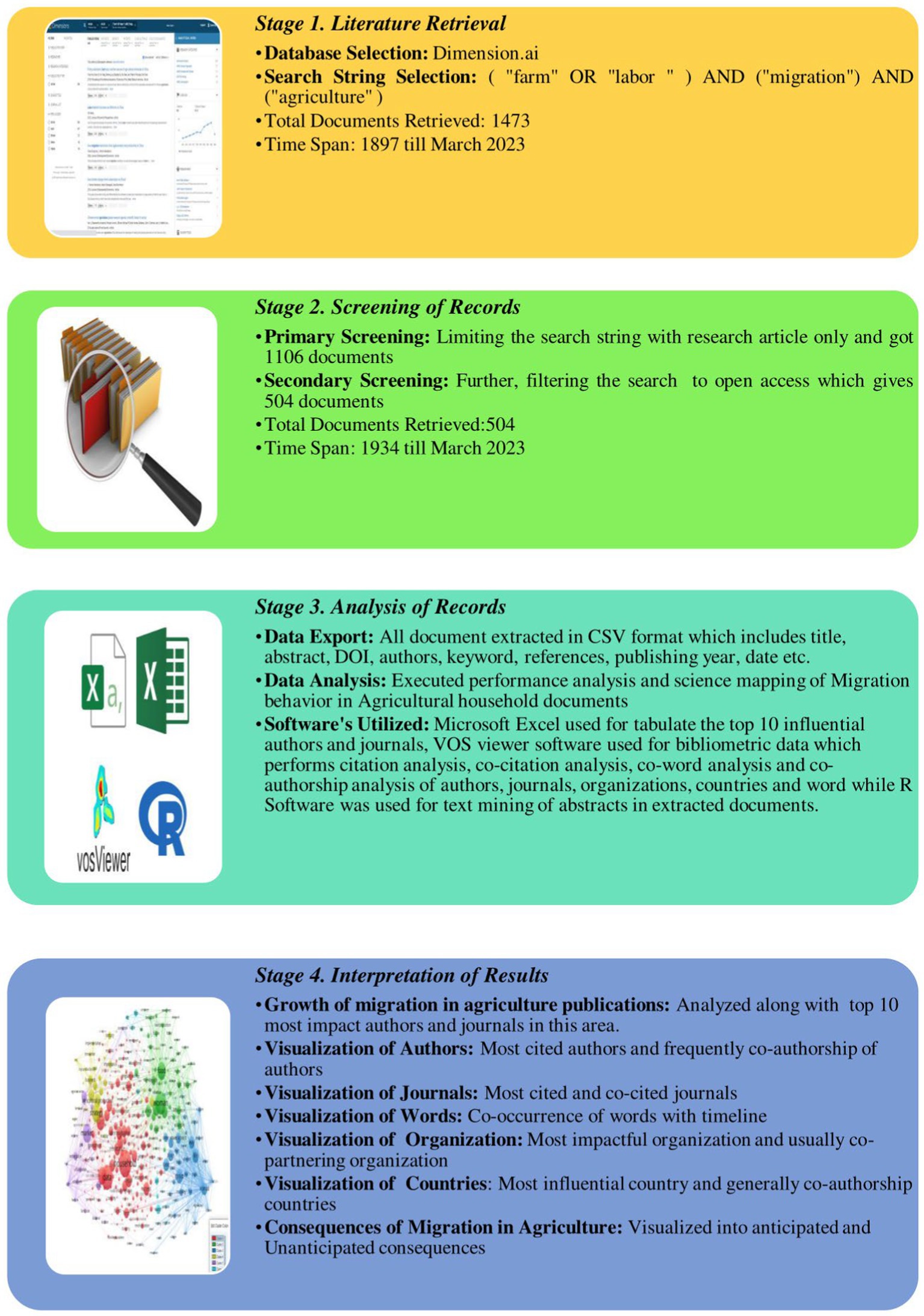
Figure 1. Detail steps of bibliometric analysis in the research study using René Descartes’s Discourse Framework.
2.3. Screening of records
For this study, the Dimensions.ai database was utilized to gather data on authors, publication titles, author affiliations, and other relevant information, making it a suitable source for bibliometric research (Hook et al., 2021). The data obtained from this database allows for various analytical overviews, including citation analysis, subject analysis, and researcher evaluation, which aids in identifying knowledge gaps (Mejjad et al., 2022; Lal et al., 2023). By focusing the search on research articles, a list of 1,106 documents were initially obtained. Subsequently, the list was narrowed down to 504 documents by applying further filters to select open-access documents covering the period from 1934 to 2023, extracted from the database.
2.4. Analysis of records
After executing the search string, the dataset obtained from the database was exported in comma-separated values (CSV) file for further analysis. Microsoft Excel was utilized to organize the data, while VOS viewer software (version 1.6.18) and R software (version 4.2.2) were employed for visualization and mapping of relationships among authors, publications, citations, countries, and keywords extracted from the documents. In bibliometric analysis, performance analysis and science mapping are two distinct techniques used to enhance the visualization of relationships among research constituents viz., authors, publications, citations, countries, and keywords (Donthu et al., 2021a). Performance analysis focuses on the contribution of research constituents, while science mapping emphasizes the interactions between these constituents (Zupic and Čater, 2013, 2015).
Performance analysis is a crucial aspect of bibliometric studies and is commonly employed to present the performance of various research constituents in a given field. To assess the performance of publications on migration behavior in agricultural households, an inclusive analysis was conducted on a dataset of 504 extracted documents. The analysis aimed to examine various performance metrics, including the growth of total publications from 1934 to 2023, the distribution of publications across different research categories, the number of publications related to SDGs, the top 10 influential journals with the highest number of publications, and the performance of the top 10 most impactful authors based on citation count (Cobo et al., 2011). Metrics such as citations per publication, h-index, i-index, and g-index are used to assess the effectiveness of research constituents by combining citations and publications (Riaman et al., 2022).
Science mapping analyzes the associations, cognitive interactions, intellectual and structural relationships among research constituents using network analysis techniques, including citation analysis, co-citation analysis, co-word analysis, and co-authorship analysis (Donthu et al., 2021a,b) using the dataset comprising 504 documents on migration studies in agricultural households. Citation analysis measures the impact and influence of publications or authors based on the number of times they have been cited. Authors and researchers are crucial in scientific endeavors as they are responsible for conducting research, analyzing data, and writing manuscripts (MacRoberts and MacRoberts, 1989; Wager and Kleinert, 2013). They bear accountability for the direct and indirect impact of their findings, contributing to the advancement of knowledge and the dissemination of clear, accurate, and balanced research outcomes (Wager and Kleinert, 2010). Citation analysis helps identify significant research constituents and their intellectual connections (Ellegaard and Wallin, 2015). Co-citation analysis establishes connections between two publications when they are cited together in the references of other publications in the research journals. Research journals play an essential role in the dissemination of scientific knowledge, serving as platforms for sharing research findings and facilitating the advancement of scientific knowledge within the scientific community (McKinley and Rose, 2018). They provide avenues for scientists to publish their work, undergo peer review, and uphold the integrity of the research process. Highly cited publications are particularly important in this networking technique, allowing for the identification of thematic clusters (Ardanuy, 2013). Co-authorship analysis examines collaborations and social connections among authors and organization, considering that co-authorship signifies shared responsibility for the work produced (Donthu et al., 2021a). In the realm of migration research in agriculture, various organizations, including research institutes, universities, government agencies, NGOs, and international organizations, are actively involved in studying the role and impact of authors in generating knowledge and addressing migration-related issues in the agricultural sector (Levitt and Schiller, 2004). Citation analysis is a widely employed method in bibliometrics and scientometrics to assess the influence and impact of scholarly work by organizations (Glanzel, 2003) in the field of migration studies in agriculture. Co-word analysis, on the other hand, analyzes the relationships between words in documents to create a conceptual framework. It identifies strongly related concepts based on the frequency of their appearance together, resulting in a network of themes and their connections, representing the conceptual space of a field (De Looze and Lemarié, 1997; Verma and Gustafsson, 2020). Co-word analysis can be applied to document titles, keywords, abstracts, and full texts (Callon et al., 1991).
To examine the consequences of migration in agriculture, text-mining techniques were employed to analyze the abstracts of 504 documents. The text mining analysis was conducted using the ‘tidyverse’ and ‘tidytext’ packages in the R software, allowing for the exploration of unigrams, bigrams, and trigrams within the abstracts (Alperin et al., 2020).
These techniques, employed in this study, aim to provide a comprehensive understanding of the research landscape on migration behavior in agricultural households and uncover valuable insights regarding research trends and thematic clusters.
3. Results
3.1. Performance analysis
The performance analysis techniques enabled the visualization of the nature and evolution of migration researches to provide valuable insights into the landscape of the domain.
3.1.1. Growth of total publications
The growth of publications in the field of migration behavior among agricultural households was evaluated to understand the overall performance. Figure 2 illustrates the analysis of the total number of publications from 2000 to 2023. The findings revealed a steady increase in the number of publications since 2003, with a significant surge observed from 2014 onwards. The highest number of publications was recorded in 2022, with 77 research articles. This was followed by 72 articles in 2021 and 59 articles in 2020, indicating a continuous interest and engagement of researchers in the topic of migration in agriculture. To gain insights into the research focus areas contributing to the increasing publication numbers, a co-word analysis was conducted on the extracted documents. This analysis facilitated the identification of major drivers of migration in agriculture based on the content of the published literature. Figure 3 presents the visualization of thematic clusters resulting from the co-word analysis. In this visualization, each thematic cluster represents a topic (words), and the relationships between the topics are depicted by the links. The overlay network in Figure 3 further organizes the clusters based on the year of publication, providing a visual representation of the evolving research themes over time (Van Eck and Waltman, 2011). The node and link structure of the thematic clusters allows for a deeper understanding of the topics covered in the research articles.
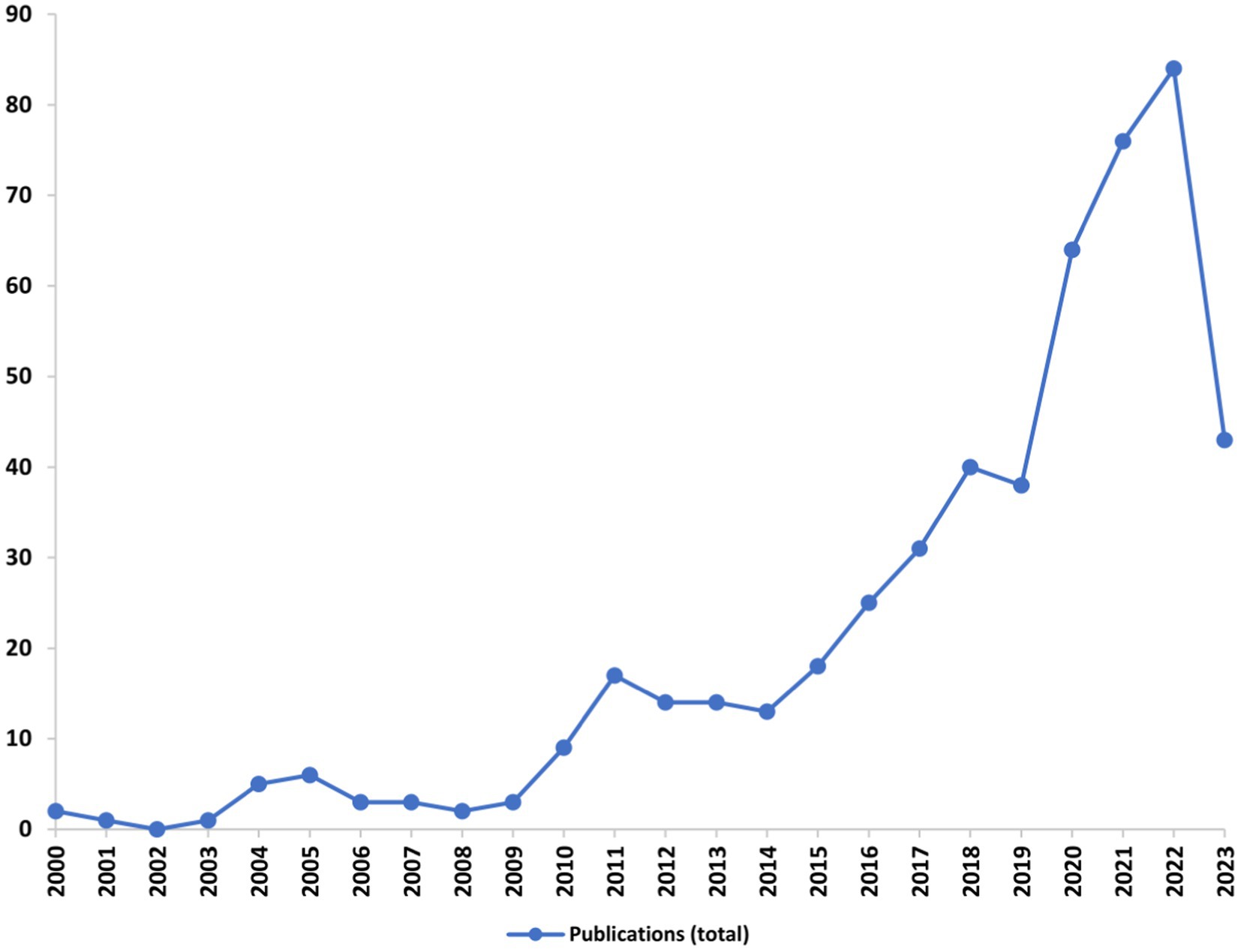
Figure 2. Growth of research publications on migration in agricultural households from the year 2000 to 2023.
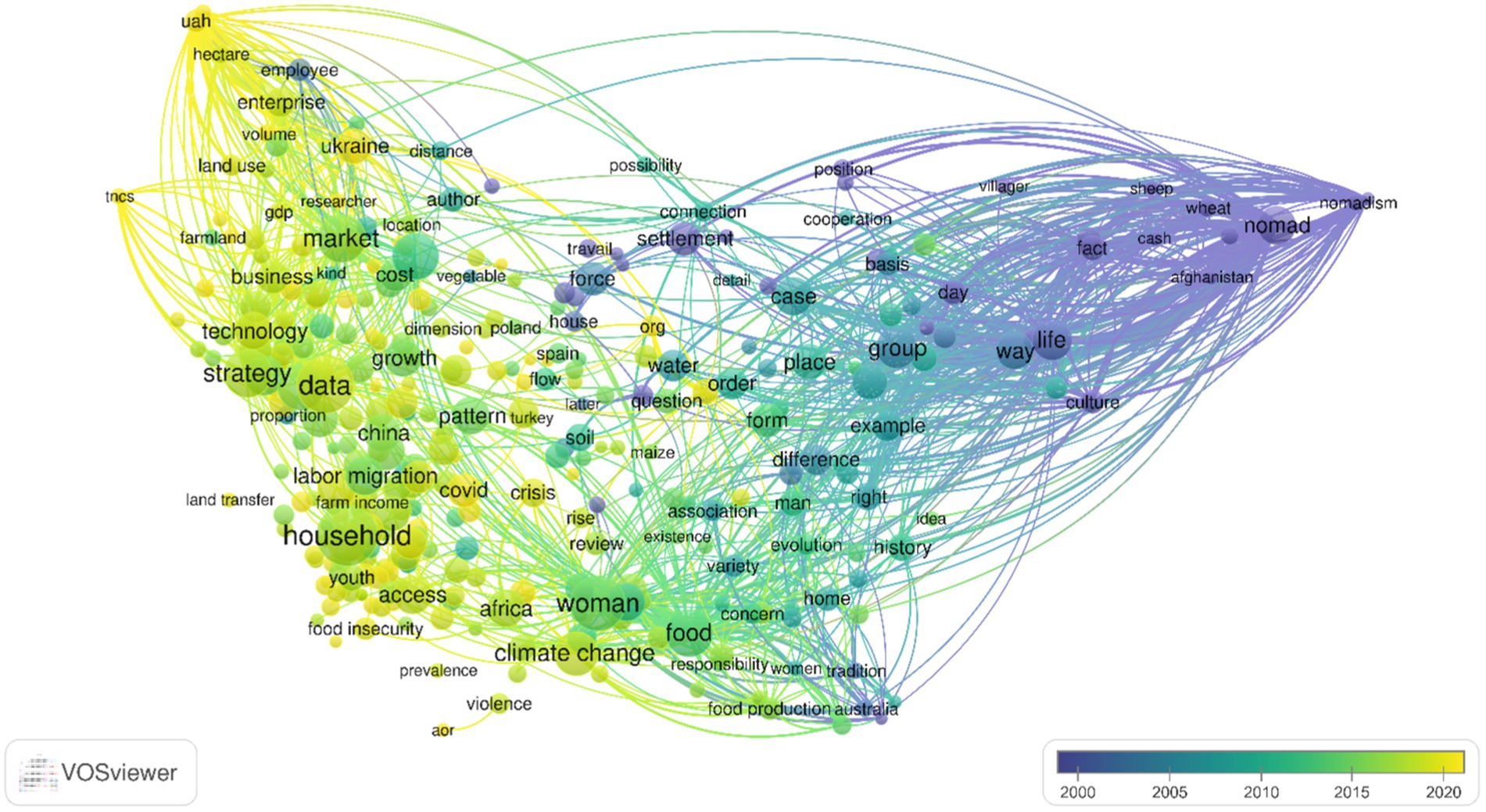
Figure 3. Overlay visual network of words in abstracts of migration behavior in agriculture household publications (each node in the network represents a word in the abstract, the line represents the link between the co-occurrence of words, and the thickness of the link signifies the strength of co-occurrence of word whereas color represents the thematic clusters of the year of publication).
3.1.2. Number of total publications in research categories and SDGs goals
Out of the 504 documents analyzed, Figure 4 illustrates the distribution of publications across different research areas. The findings indicate that the highest number of publications were in the area of human society (345), followed by agriculture, veterinary, and food science (48) and environmental sciences (48). Furthermore, Figure 5 provides insights into the number of publications related to SDGs. It reveals that among the SDGs, Goal 2 (Zero Hunger) had the highest number of publications, with 187 articles focusing on this theme. This is followed by Goal 8 (Decent Work and Economic Growth) and Goal 15 (Life on Land), with 161 and 51 publications, respectively, addressing the topic of migration within the context of these SDGs. These findings highlight the significance of addressing issues related to food security, employment opportunities, and environmental sustainability in the context of migration.
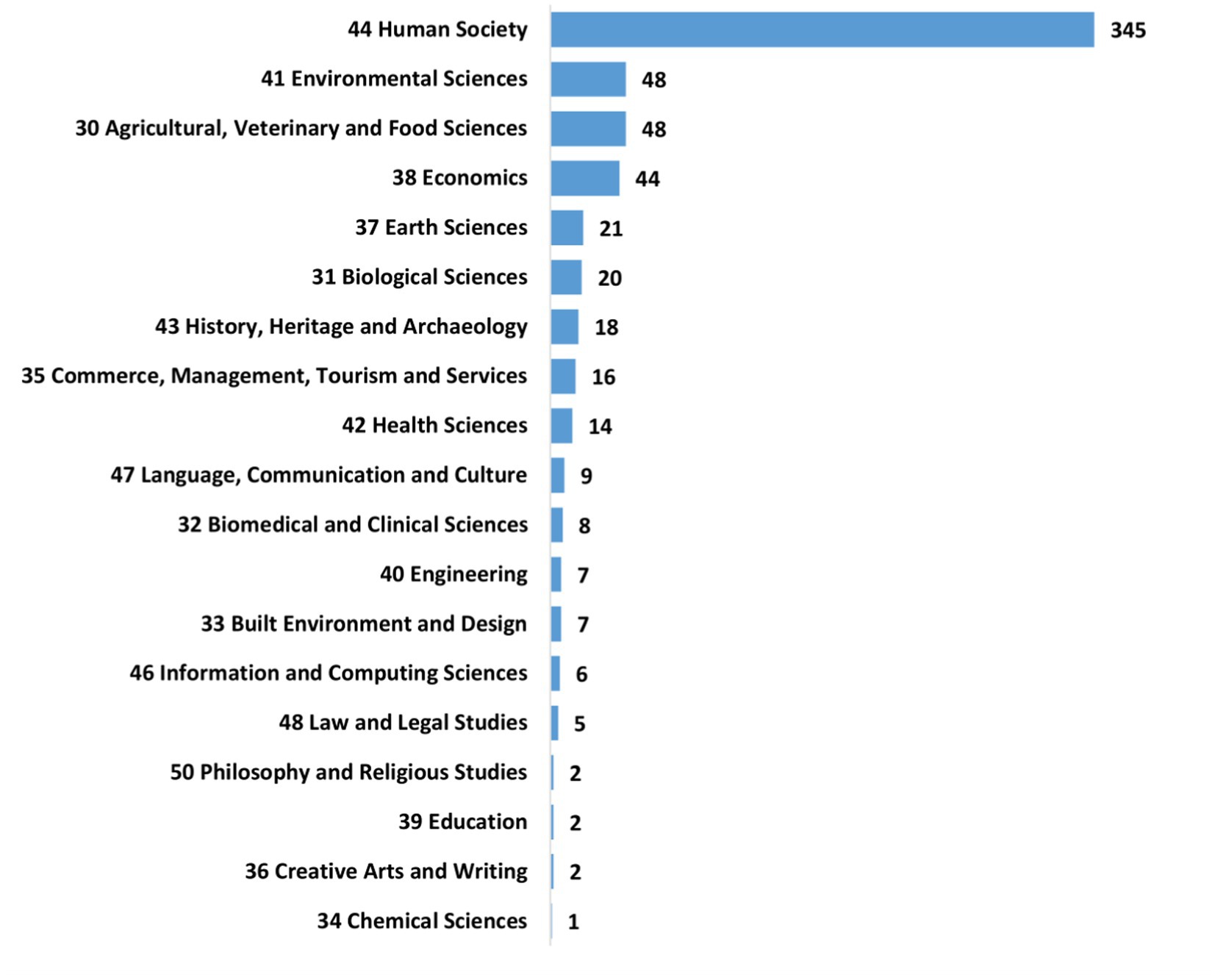
Figure 4. The number of migration publications in agriculture published under various research categories from the year 1934 to 2023.
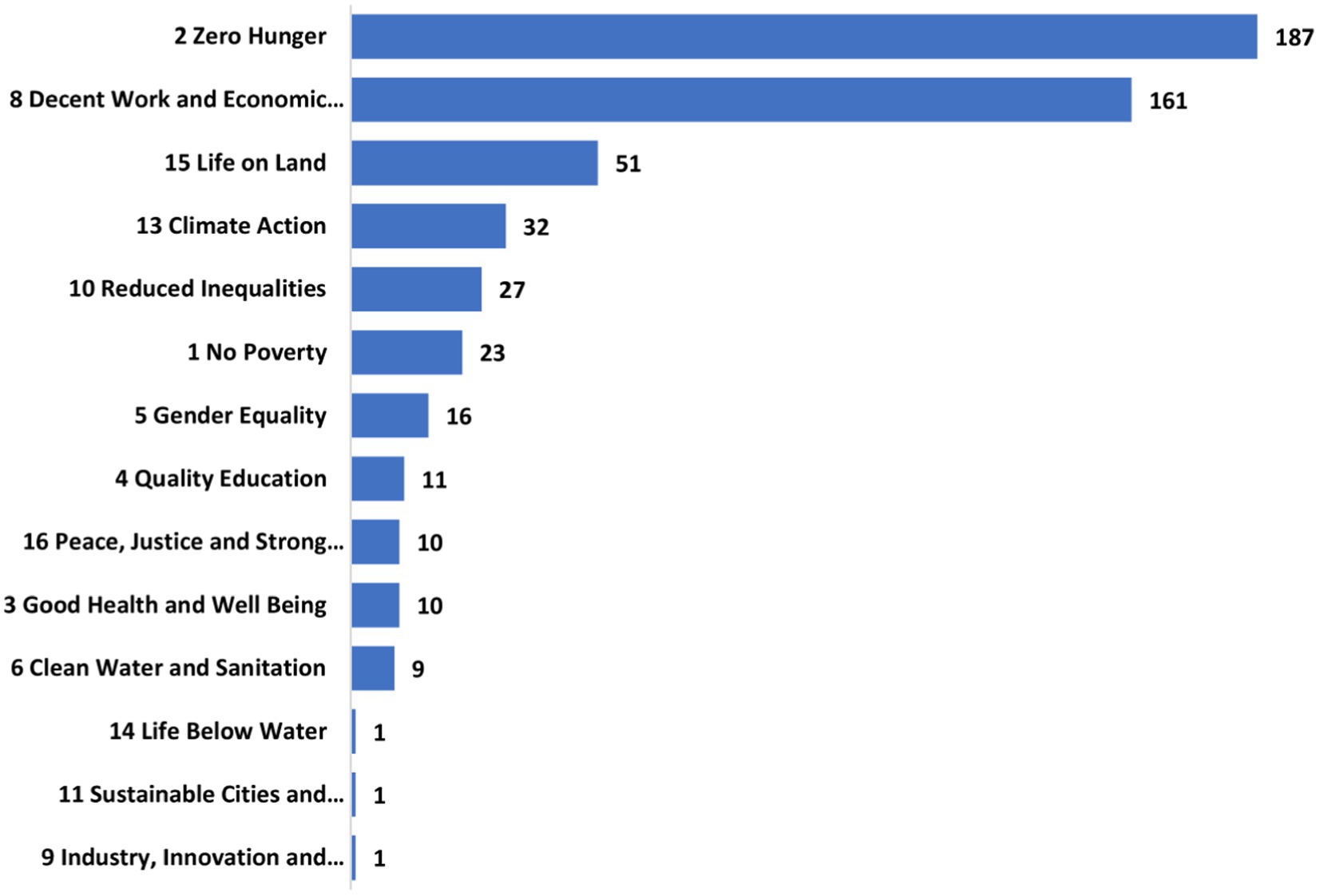
Figure 5. The number of migration publications in agriculture published under each SDG goal from the year 1934 to 2023.
3.1.3. The top 10 most influential journals and authors
Table 1 presents the top 10 influential journals in the field of agriculture that have published the highest number of documents related to migration studies, as determined through performance analysis. The findings indicate that the three most impactful journals were World Development, published by Elsevier, with 11 documents and 475 citations; Journal of Rural Studies, also published by Elsevier, with 10 documents and 155 citations and Sustainability, published by MDPI, with 13 documents and 146 citations. Similarly, Table 2 showcases the top 10 most influential authors based on the number of citations their publications on migration studies in agriculture have received. The author J. Vernon Henderson, affiliated with the London School of Economics and Political Science, United Kingdom, emerges as the most impactful author with 417 citations for three documents. These findings highlight the significant contributions made by these journals and authors in advancing the knowledge and understanding of migration in the context of agricultural studies.
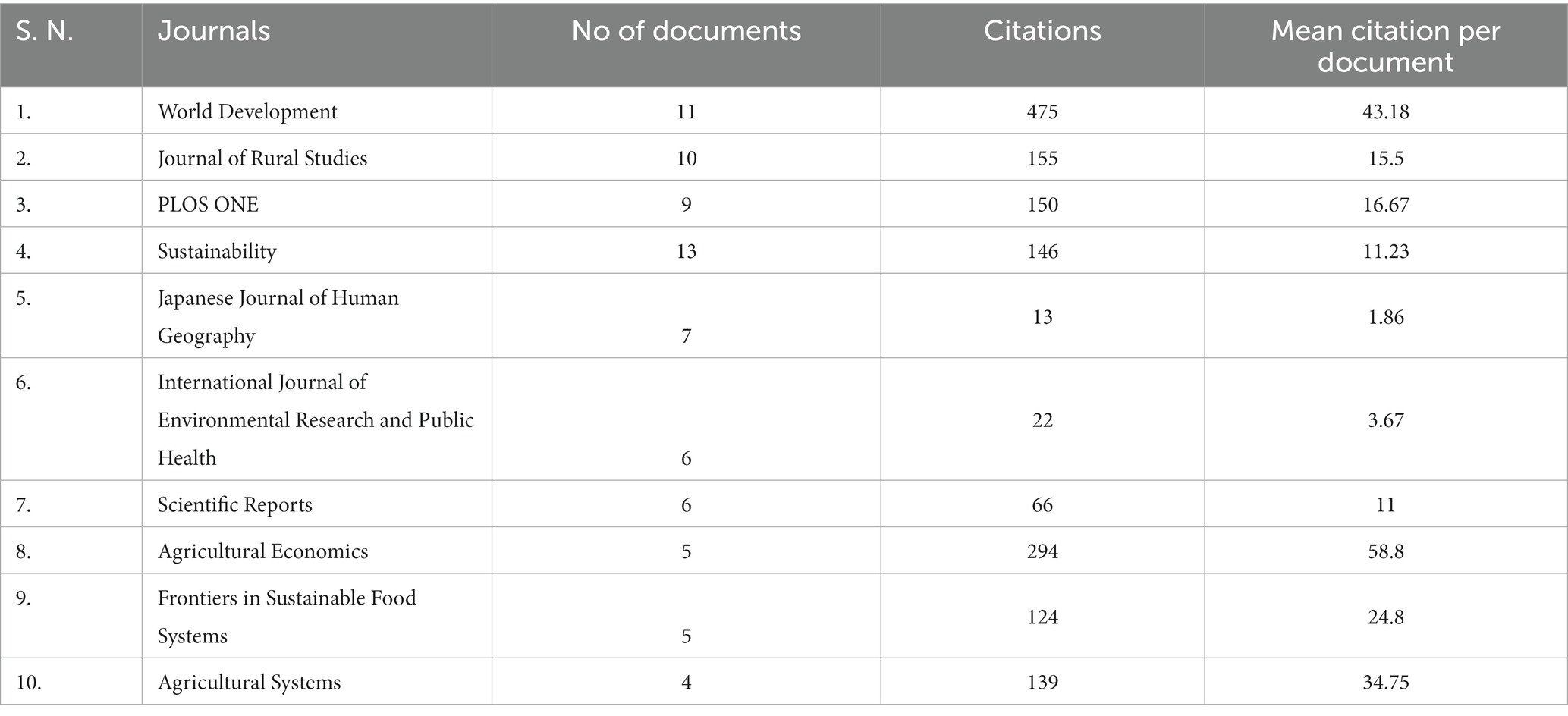
Table 1. The top 10 most influential journal’s performance on migration in agriculture literature publishing research articles.
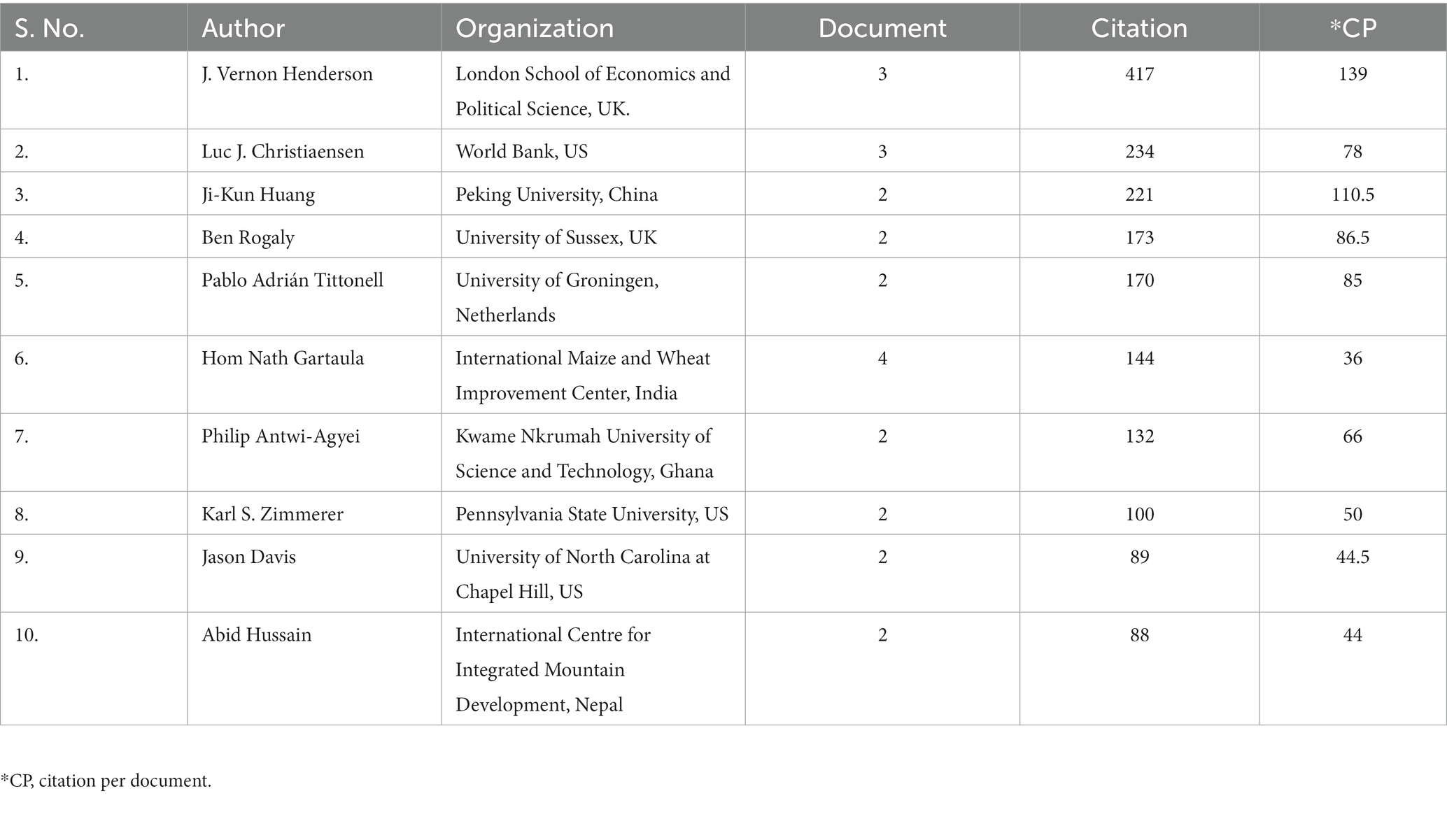
Table 2. The top 10 most influential author’s performance working on migration in agriculture from the year 1934 to 2023.
3.2. Science mapping
The Science mapping techniques enabled the exploration and visualization of the interconnectedness and patterns within the collected data, providing valuable insights into the intellectual landscape of the field (Misara et al., 2022).
3.2.1. Visualization of authors
To gain insights into the network of authors and their scholarly impact, citation analysis and co-authorship analysis were conducted. Citation analysis examined the number of citations received by each author, resulting in the formation of seven thematic clusters visualized in Figure 6. Authors with the highest number of citations were depicted in red, while those with fewer citations appeared in blue. This visualization provides a representation of the varying levels of scholarly impact among authors. On the other hand, co-authorship analysis focused on the social network of authors by examining their collaborations in research publications. Figure 7 displays the co-authorship network, where authors are connected if they have collaborated as co-authors. The analysis resulted in the formation of three clusters namely, a red cluster consisting of 14 researchers, a green cluster with 11 researchers, and a blue cluster with nine researchers. These clusters represent the groups of authors who have collaborated frequently based on the number of publications they co-authored. Overall, the citation analysis and co-authorship analysis shed light on the scholarly impact and collaborative networks among authors in the field of migration studies in agricultural households.
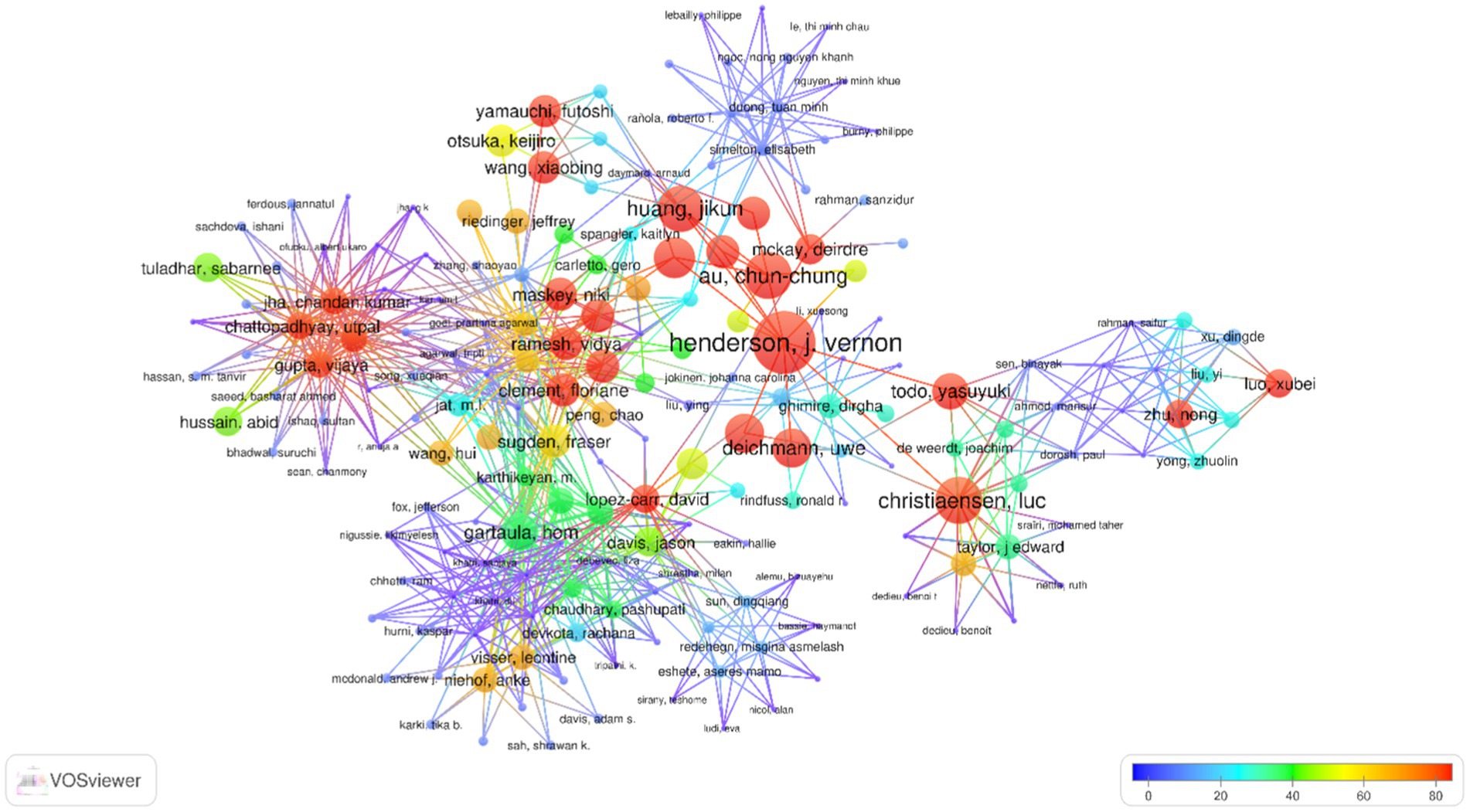
Figure 6. Citation analysis of authors of migration studies since 1934 (each node representing the author, line representing the link between the authors, whereas the thickness of the link signifies the relatedness of authors who cited the other author while color reflects the thematic clusters of citations of publication).
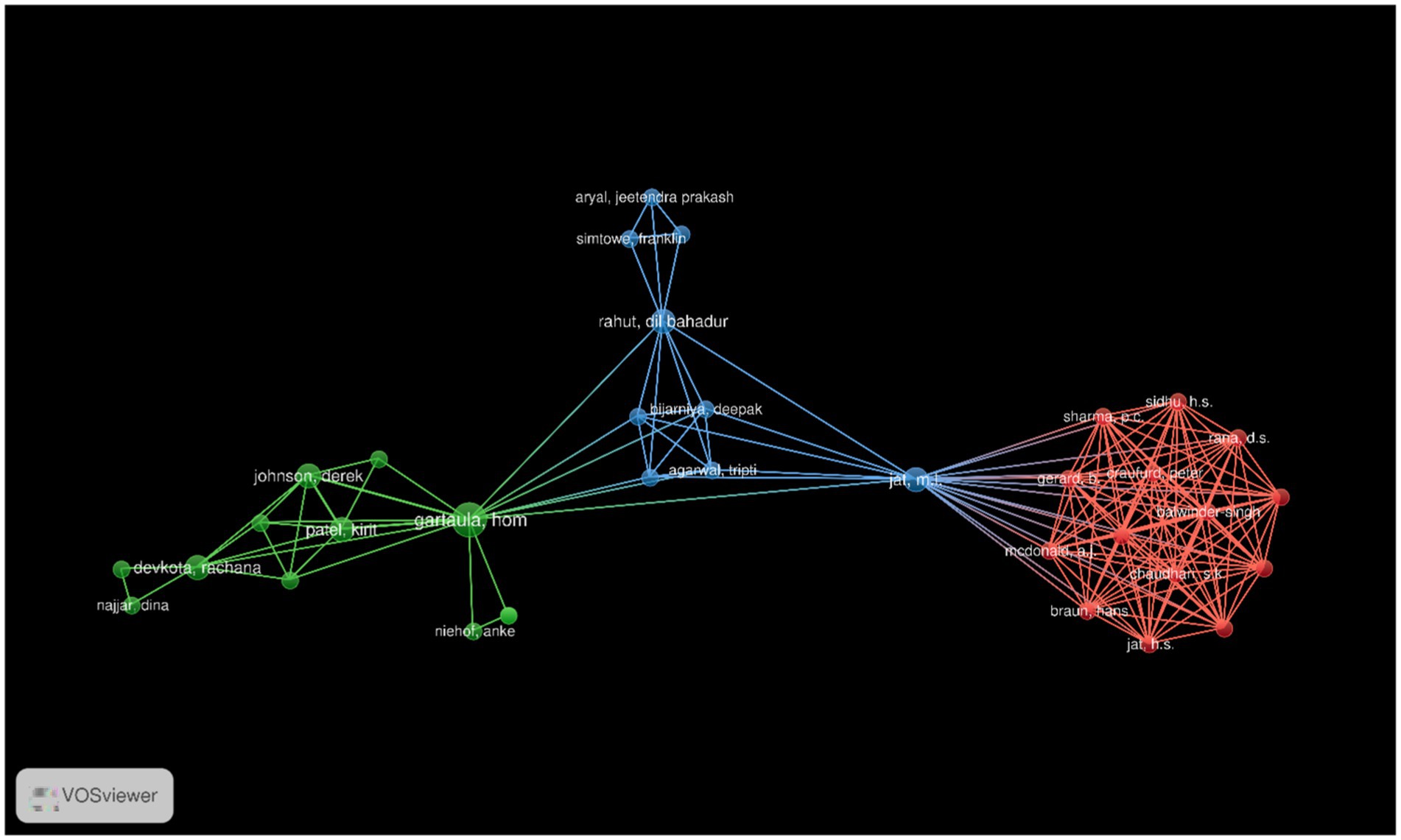
Figure 7. Co-authorship analysis of authors of research publications of migration in agriculture studies from 1934 to 2023 (each node representing the author, line representing the link between the co-authors whereas the thickness of link signifies the strength of authors who are co-authors in research publications while color reflecting the thematic clusters of co-authorship of publication).
3.2.2. Visualization of journals
To evaluate the impact of journals, a citation analysis was conducted. This analysis focused on determining the influential journals in the field by examining the number of citations received by each journal. In the visualization presented in Figure 8, journals are represented as nodes, with their size indicating the number of citations received. The color coding of the nodes represents the year in which the journals were cited. The analysis resulted in the formation of four clusters, reflecting different groups of journals based on their citation patterns. Co-citation analysis, on the other hand, examines the relationships between scientific journals based on the frequency with which they are cited together in the reference lists of other articles (Zupic and Cater, 2013). This analysis helps identify clusters of journals that are frequently co-cited. Figure 9 represents the co-citation network, where journals are connected if they are frequently cited together. The visualization reveals the formation of three clusters, indicating the presence of distinct groups of journals that are frequently referenced together in publications. Both the citation analysis and co-citation analysis provide appreciable insights into the impact and relationships among journals in the field of migration studies in agricultural households.
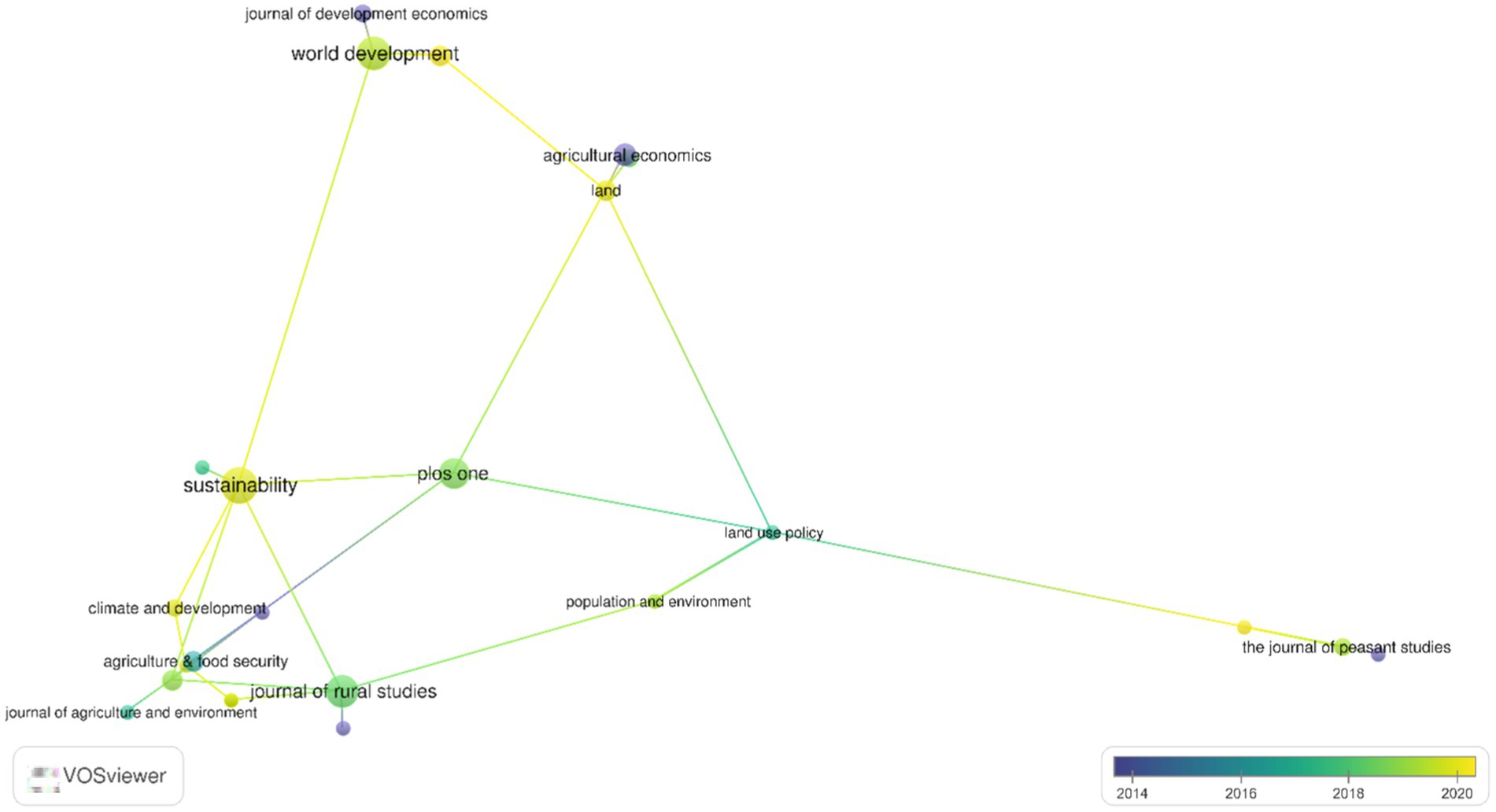
Figure 8. Citation analysis of journals that published the research articles on migration theme during the study (each node representing the journal, line representing the link while thickness indicates the relatedness of journals who cited other journals which color reflecting the duration of citations of articles).
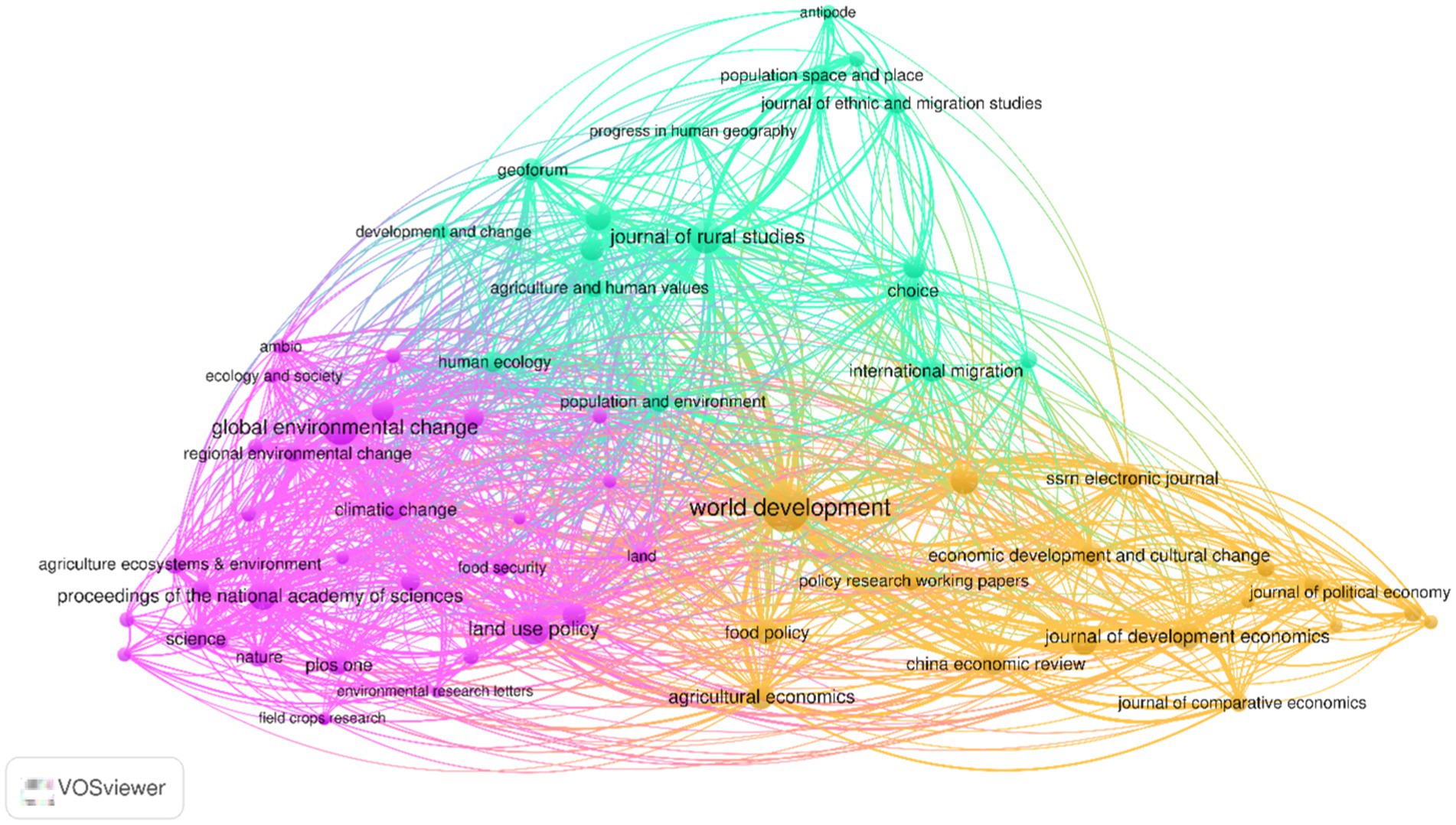
Figure 9. Co-citation analysis of journals published the research articles on migration (each node representing the journal, the line representing the link between the journals co-cited whereas the thickness of the link signifies the strength of co-occurrence of journals in research publications while color reflecting the thematic clusters of co-occurrences).
3.2.3. Visualization of words
To gain a deeper understanding of the conceptual frameworks and relationships among keywords related to migration behavior in agricultural households, a co-word analysis was conducted. This analysis utilized the VOS viewer software to visualize the data (Van Eck and Waltman, 2010), resulting in the identification of six clusters, each represented by a node (word) and links indicating their relationships, as shown in Figure 10. The first theme cluster, depicted in red, consisted of 168 words that frequently appeared in the dataset. Keywords in this cluster included household, labor, migration, pattern, and force, highlighting their significance in the context of migration behavior among agricultural households. The second theme cluster, depicted in green, comprised 60 words. Noteworthy words in this cluster included women, food, climate change, food production, the COVID crisis, and violence, indicating the importance of these topics about migration behavior in agriculture. The third theme cluster, represented in blue, consisted of 45 words, including nomadism, group, culture, life, villagers, dependence, cash, and credit. These words emphasized the social and cultural aspects of migration in agricultural communities. The fourth cluster, depicted in yellow, contained 29 words, with technology, business, strategy, and settlement being the prominent keywords. This cluster highlighted the role of technology, business strategies, and settlement patterns in the context of migration. The fifth theme cluster, represented in purple, included words such as market, enterprise, employee, and GDP, indicating the economic dimensions associated with migration in agriculture. Lastly, the sixth theme cluster, depicted in cyan, comprised 10 words related to water, soil, cattle, and irrigation, emphasizing the significance of agricultural resources and practices. By analyzing the co-occurrence of keywords, this co-word analysis provided insights into the thematic clusters and the relationships among keywords in the field of migration behavior in agricultural households.

Figure 10. Network of co-word analysis of the title and abstracts of a research article (node indicating the word, line representing the link with words whereas indicating the co-occurrence of words wherein the color of cluster reflecting the themes having topics (words) and their relationship (links) in thematic clusters).
3.2.4. Visualization of organizations
To visualize the density of migration publications associated with different organizations, a network map was created, as depicted in Figure 11. The World Bank emerged as the organization with the highest number of citations (658), displaying connections with 21 other organizations. This visualization provides insights into the impact and influence of the World Bank’s publications in the field of migration in agriculture. Furthermore, a co-authorship analysis of organizations was conducted to identify collaborations among research organizations, as shown in Figure 12. The analysis resulted in the identification of four thematic clusters depicted in red, green, yellow, and blue, representing collaborations in publications. In the red cluster, the London School of Economics and Political Science formed a network with four other institutions and garnered the highest number of citations for their publications. In the green cluster, the World Bank was prominently connected, while in the yellow cluster, Wageningen University and Research had the most citations among their collaborators. These findings shed light on the collaborative networks and impact of organizations in the field of migration studies in agriculture.
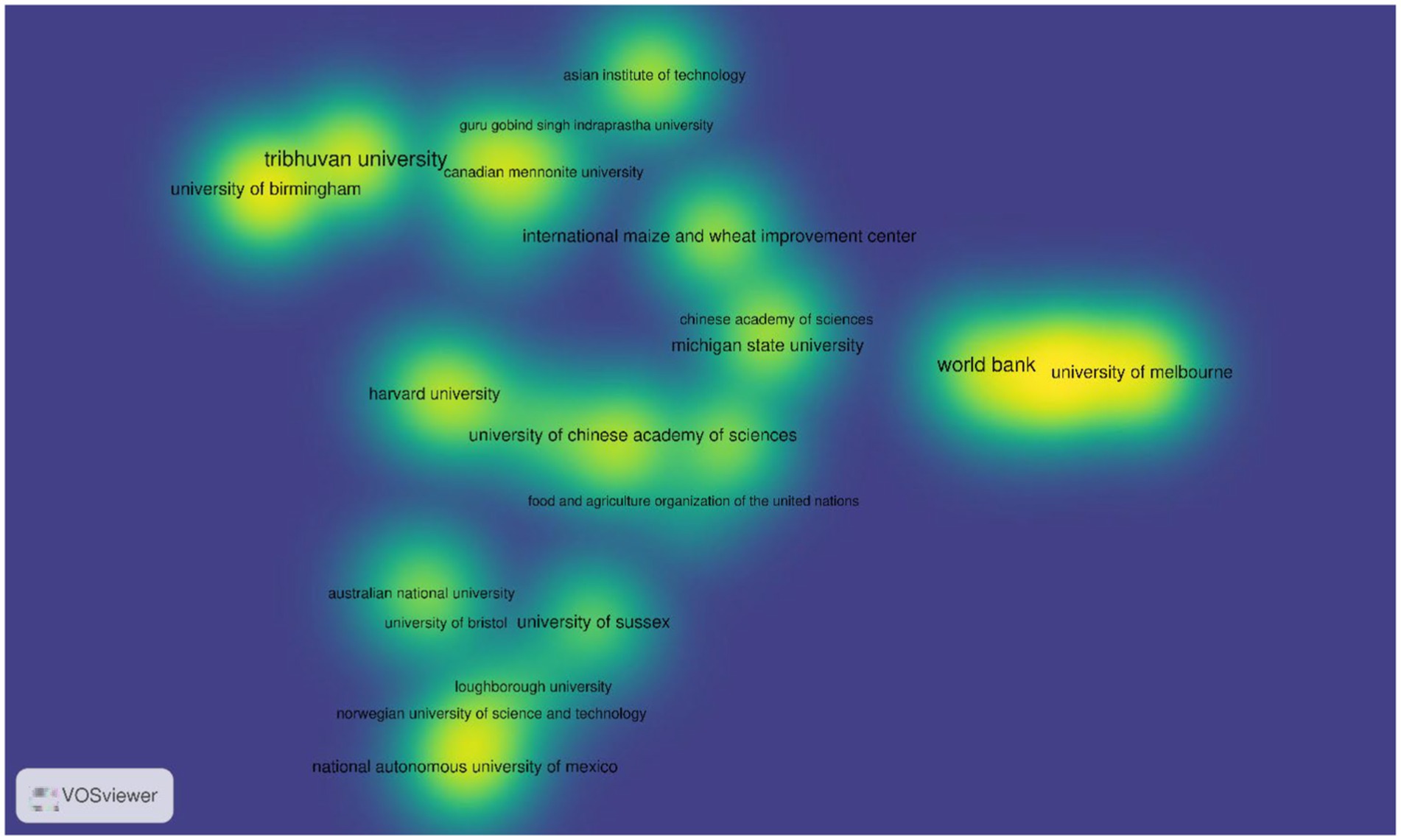
Figure 11. Citation analysis of organization plotted as an item density map (each item represented by the organization and its density reflected by the number of citations received by the organization).
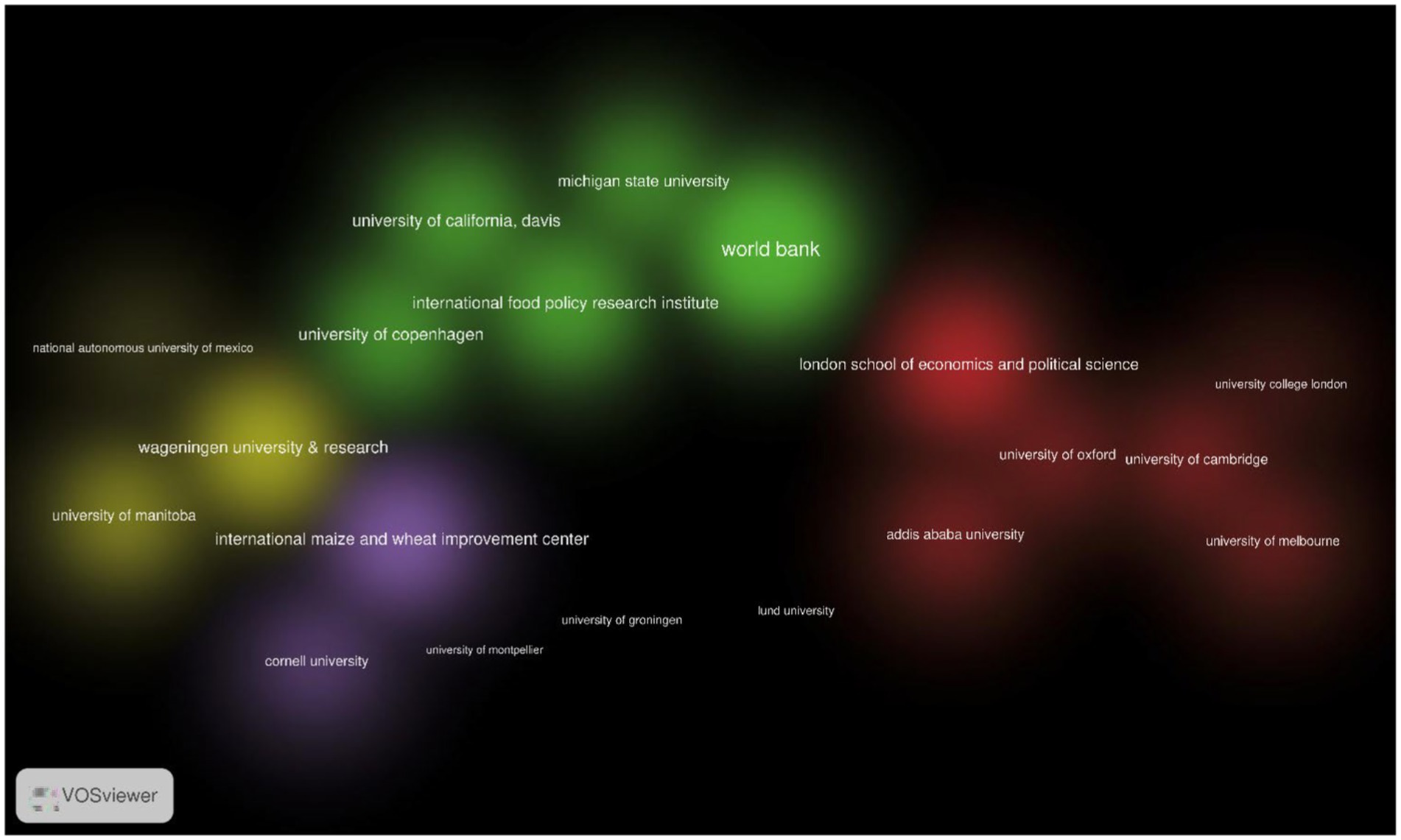
Figure 12. Visualization of co-authorship analysis among organizations as cluster density map (each node represented by the organization while the density of clusters represents the co-authorship of organizations in research publications).
3.2.5. Visualization of countries
Network analysis provides researchers with a broad understanding of the role, contributions, and impact of different countries in the field of migration studies in agriculture. By employing network analysis, which integrates both qualitative and quantitative approaches, researchers can gain a holistic perspective on the involvement, collaboration, and influence of countries in this field. Figure 13 depicts citation maps for countries, where the size of each node represents the number of citations received by documents originating from that country, and the color represents the year of publication as suggested by Glanzel (2003). Furthermore, co-authorship analysis was conducted to examine the collaboration between countries (Ellegaard and Wallin, 2015). Figure 14 showcases seven thematic clouds, each representing collaborations among countries in the publication of migration studies. These thematic clouds highlight the different networks and patterns of collaboration that have emerged among countries in the field. The United States has collaborative relationships with other counties and contributions to the study of migration in agriculture. This knowledge can enhance understanding and facilitate future research and policy development in collaboration with the United States in the field of migration studies in agriculture.

Figure 13. Citation analysis of countries working on migration issues in agriculture (each node representing the country, line representing the link between countries while thickness of link relatedness of countries who cited the other countries publication whereas color reflecting the duration of publication of articles).

Figure 14. Visualization of co-authorship analysis of countries working in migration issues in agriculture (each node representing the country, line representing the link between countries who co-authored in publications while thickness of link strength of countries who co-authored in other countries publication whereas color reflecting co-authorship of publication of articles).
3.2.6. Consequences of migration behavior in agriculture
To facilitate clear and understandable findings, the frequencies of trigrams were extracted and visualized using radial plots, as shown in Figure 15. By analyzing the abstracts, the most frequently occurring three-word combinations were identified, providing insights into the anticipated and unanticipated consequences of migration in agricultural households as evaluated by Moraru and Munteanu (2015). The visualization in Figure 15 categorizes these three-word combinations, shedding light on the various aspects and implications of migration in agriculture. Through this text-mining analysis, researchers can gain a deeper understanding of the effects and consequences associated with migration in agricultural settings. These findings can contribute to informed decision-making, policy development, and future research in the field of migration studies in agriculture.
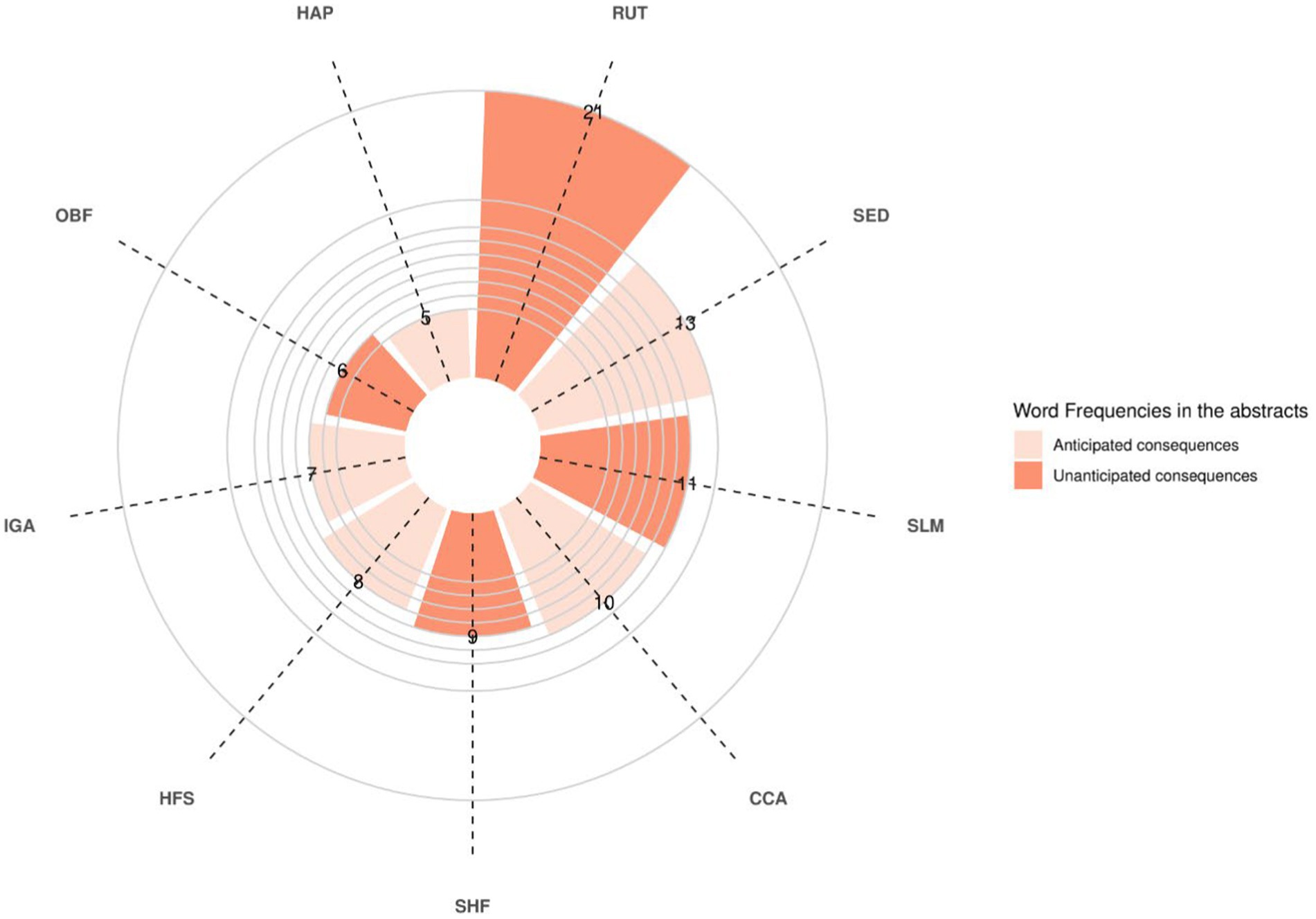
Figure 15. Frequently used trigrams in the abstracts of migration behavior in agriculture from the published article from 1934 to 2023 (SED: socio-economic development, CCA: climate change adaption, HFS: household food security, IGA: income generating activity, HAP: household adoption practice, RUT: rural to urban transition, SLM: seasonal labour migration, SHF: smallholder farmers, OBF: overburden’s female).
4. Discussion
Since 2014, there has been a significant increase in the number of open-access research articles focusing on migration behavior in agriculture. This growth has allowed for the identification of key drivers of migration in recent years, including food insecurity, COVID crises, climate change, labor migration, technology-driven markets, and business (Saxena et al., 2020; Smith and Wesselbaum, 2020; Saini et al., 2023). Previous research trends in agricultural households have also addressed gender and women’s sensitivity, nomadic cultural lifestyles, and the natural life of migrants (McKay, 2005). These trends were identified because of emerging issues like climate change and natural disasters with the commences of artificial intelligences and technological advancement in the agricultural sector. They showcase the evolving pattern of migration since the last few decades. The category with the highest number of migration publications in agriculture was human society. Within this category, a research articles from China on farm size, policy distortions, and the overuse of chemicals leading to farmer migration received the maximum citations (393; Garfield, 1972), with a high altmetric score of 90 (Trueger et al., 2015). This highlights the significant problems and reasons behind migration in agriculture (Wu et al., 2018). In pursuit of sustainable development, the United Nations (UN) has identified 17 SDGs with a focus on inclusiveness. To ensure that no one is left behind, the UN has taken various initiatives and implemented transformative policies that consider migrants as key actors in boosting economic production (IOM, 2021). Policymakers and researchers must recognize the identified research gaps in agricultural households concerning migrants, particularly about the indicators of SDGs. Therefore, this study sheds light on the research considerations for achieving SDG goals related to migrants in areas such as food security (Hussain et al., 2016; Kumar and Sharma, 2020), decent work (Fan and Chan-Kang, 2005; Rogaly, 2009; Deininger et al., 2014), and improved quality of life (McKay, 2005; Davis and Lopez-Carr, 2014). The analysis of published research articles from 1934 to 2023 reveals that these topics have received significant attention and represent important areas of focus for achieving sustainable development in the context of migration in agricultural households.
Among the authors, J Vernon Henderson emerged as the most influential researcher in the field. His works on climate change-driven migration (Henderson et al., 2017), the insufficient agglomeration of migrants (Au and Henderson, 2006), and the income gap as a cause of migration in households (Henderson and Kriticos, 2018) have received significant citations in related studies. Since the last decade issue of Climate change was emerged as the prominent concern for the sustainable increase of productivity and income for the farmers. J Vernon Henderson is a highly regarded researcher in the field of urban and development economics, with 42,741 citations (Moed, 2006), an h-index (Hirsch, 2005) of 85, and an i10-index (Teixeira da Silva, 2021) of 165 for his research publications on Google Scholar in 2023. The collaboration among authors in migration studies of agricultural households was visualized in Figure 7, forming three distinct clusters. According to Granovetter (1973), authors who bridge two or more heterogeneous groups (cliques) within a research area are referred to as bridge links. In this context, authors such as M. L. Jat, Hom Gartaula, and Dil Bahadur Rahut serve as bridge links connecting the three social network groups in migration studies. Their co-authorship in research publications spans across different social network groups, facilitating collaboration and knowledge exchange among diverse research clusters. The growing imperative to address Sustainable Development Goals (SDGs), enhance food and nutritional security, and adapt to climate change has led to a rise in both national and international collaborations among authors over the years. The most influential journal identified through citation analysis since 2020 was Sustainability, an international, cross-disciplinary, scholarly peer-reviewed, open-access journal. With an impact factor (Hirsch, 2005) of 3.889 and a cite score of 5.8, Sustainability published 13 articles on migration in agriculture, receiving 146 citations. World Development and Journal of Rural Studies were also influential journals in the field of migration studies since few last decades. This network analysis technique provides valuable insights into the visibility, reputation, and quality of the journal within the scientific community (Waltman, 2016). By examining the co-citation patterns of migration studies journals, the intellectual connections and thematic relationships between journals can be identified, shedding light on the structure and dynamics of the migration research field, as illustrated in Figure 9. The network consists of nodes representing journals and edges representing the co-citation links between them. Analyzing this network allows researchers to uncover clusters and communities of related journals and evaluate their centrality within the network, providing an understanding of the strength of the relationship between journals and the intellectual connections they share (Small, 1973; White and Griffith, 1981). In the network, World Development, Global Environmental Change, and Journal of Rural Studies are central nodes in the orange, pink, and cyan clusters, respectively. These journals were frequently co-cited together in the reference lists of migration articles in agriculture, indicating their significant role and influence in the field. These journals have an interdisciplinary focus and boast a rich history and esteemed reputation within their specific domains. They rigorously subject research to peer review to uphold quality standards and cater to a wide readership. Consequently, authors frequently cite research published in these journals.
The co-word analysis examined the frameworks of various keywords and their relationships, resulting in the identification of six clusters representing different themes. The analysis revealed that migration literature from an agricultural perspective focuses on several major areas, including climate change (Steenwerth et al., 2014; Henderson et al., 2017), food insecurity (Saxena et al., 2020), COVID crises (Smith and Wesselbaum, 2020), reduced off-farm employment opportunities in rural areas (Abdul and Aparajita, 2019), changing market patterns (Meng, 2012), fragmentation of farm size (Wu et al., 2018), and agricultural production (Au and Henderson, 2006). These themes mapped the relationships and frequency of non-identical word clusters across different time periods, using data collected during the study. Since the onset of the COVID-19 pandemic, there has been a heightened research emphasis on migration studies in developing countries. The diminishing job opportunities for farmers due to climate change and the depletion of natural resources have long been a hotspot of research aimed at achieving sustainable income growth for farmers. This analysis provides insights into the prominent areas of research and the interconnections between different keywords in the migration literature from an agricultural perspective.
The analysis of organization aimed to explore the social, economic, and environmental dimensions of the publications and provide insights into the intellectual connections, knowledge dissemination, and the significance of different organizations within the migration research field. Among these organizations, the World Bank, an international financial institution, was found to have the highest number of citations. The World Bank has been actively working on addressing global economic imbalances (Ratha et al., 2019), understanding demographic changes (Bloom and Williamson, 1998), and studying the challenges and opportunities associated with migration (McKenzie and Sasin, 2007; Murrugarra et al., 2010) across countries. Furthermore, in the co-authorship analysis of organizations, relationships, and collaborations with other organizations involved in migration studies in agriculture. This analysis provided insights into the collaborations and partnerships among organizations working in the field of migration in agriculture, highlighting the interconnectedness and shared research interests among them. International organizations worldwide are persistently dedicated to addressing and mitigating the impact of migration on rural populations. Citation analysis is a valuable method for identifying the countries that are frequently cited in research publications on migration in agriculture from different countries (Abramo et al., 2012). In Figure 13, the number of citations for each country is visualized. The United States and the United Kingdom have received 2,628 and 1,248 citations, respectively, indicating their significant contributions to the field. On the other hand, countries such as India, China, and Thailand have shown a higher number of average publications since 2020, suggesting their increasing engagement in research on migration in agriculture. In Figure 14, the co-authorship network of countries is displayed, illustrating the collaborations among authors from various countries in migration studies of agricultural households. The United States, United Kingdom, China, Canada, France, and Australia are prominent in terms of their maximum co-authorships with different countries. These collaborations signify the global nature of migration research in agriculture and highlight the geographical distribution of publications across various themes. The interactions among authors from different countries contribute to the advancement of knowledge and the development of comprehensive perspectives in the field.
The consequences refer to the effects that occur as a result of an innovation or activity within a social system (Rogers, 2010; Obi et al., 2020). In the context of migration behavior in agriculture, understanding the consequences is crucial for addressing the concerns of farmers and stakeholders in the agricultural sector. The consequences of migration behavior are analyzed and categorized into two main types, namely, anticipated and unanticipated consequences. Anticipated consequences are the intended and recognized effects of migration from agriculture. These include socio-economic development (SED) of farming households (McKay, 2005; Basu, 2013), strategies for climate change adaptation (CCA; Dhungana et al., 2020; Antwi-Agyei and Nyantakyi-Frimpong, 2021; Maharjan et al., 2021) to achieve household food security (HFS; Gartaula et al., 2012; Shirsath et al., 2020), increased income-generating activities (IGA; Weldegebriel and Prowse, 2017), and household adoption practices (HAP; Dhungana et al., 2020). These consequences are anticipated and expected outcomes of migration from agriculture. On the other hand, unanticipated consequences of migration are derived from the analysis of abstracts. These consequences include rural-to-urban transition (RUT; Christiaensen and Todo, 2014), seasonal labor migration (SLM; Rogaly et al., 2002), which can lead to unemployment for smallholder farmers (SHF) during the off-season, thereby pushing them to participate in forced migration. Another unanticipated consequence is the increased burden on female (OBF) household members (Brumer, 2004; Singh, 2018), who may experience additional responsibilities and tasks related to domestic and farm activities. These unanticipated consequences highlight the unintended effects of migration in agricultural households. By categorizing the consequences into anticipated and unanticipated, researchers gained a deeper understanding of the various impacts and implications of migration behavior in agriculture. This information can help policymakers, stakeholders, and researchers address the challenges and opportunities associated with migration and develop strategies to mitigate negative consequences while maximizing positive ones.
5. Conclusion
From the present study, it can be concluded that migration in agriculture is a complex phenomenon with various reasons and outcomes, affecting different aspects of society, economy, structure, and demographics. Through an extensive bibliometric analysis, it was observed that there has been a growing interest in studying migration behavior in agricultural households over the past few decades which was testified by the increasing number of publications in this area in scholarly discussions. The findings highlighted the interdisciplinary nature of migration behavior in agricultural households, drawing contributions from fields such as agricultural economics, rural sociology, development studies, and environmental science which can foster collaborations and contribute to a comprehensive understanding of the complex dynamics of migration in agricultural contexts. The evolving migration behavioral research emphasizes the concern of providing higher and stable employment opportunities as well as improved living conditions, better access to healthcare, education, and infrastructure for the migrants. The mechanization and technological advancements in the agriculture sector coupled with increasing climate change and natural disasters, disrupts the quality of life of farmers. The findings underscore the need for education and skill development among farmers, particularly among farm women and youth, to influence the direction and pace of migration. The findings also aligns with the United Nations’ goal of leaving no one behind and addresses important dimensions such as gender, environmental factors, and the role of social networks in migration behavior and can furnish policymakers, practitioners, and researchers with contemporary and relevant data, empowering them to make informed decisions regarding research prioritization, collaboration and networking, policy and practice recommendations, fund allocation, and knowledge dissemination. However, it is imperative to acknowledge that these insights may exhibit inconsistencies and be subject to publication biases. Nonetheless, they have the potential to translate into tangible outcomes such as progress in research, evidence-based policies, enhanced practices, and strengthened collaboration among researchers, organizations, and countries engaged in the study of migration in agriculture.
Data availability statement
The original contributions presented in the study are included in the article/supplementary material, further inquiries can be directed to the corresponding authors.
Author contributions
SS, RB, and RP have done the conceptualization and design of the study. SS, GM, SB, KA, and MN led the software analysis and interpretation of data. SS, SoM, SwM, and SP led the original draft preparation and proofreading. All authors contributed to the article and approved the submitted version.
Acknowledgments
The authors acknowledge the ICAR-Indian Agricultural Research Institute and the Indian Council of Agricultural Research, New Delhi, India, for the financial support and necessary facilities.
Conflict of interest
The authors declare that the research was conducted in the absence of any commercial or financial relationships that could be construed as a potential conflict of interest.
Publisher’s note
All claims expressed in this article are solely those of the authors and do not necessarily represent those of their affiliated organizations, or those of the publisher, the editors and the reviewers. Any product that may be evaluated in this article, or claim that may be made by its manufacturer, is not guaranteed or endorsed by the publisher.
Footnotes
References
Abdul, J., and Aparajita, C. (2019). Livelihood crisis and distress: seasonal migration in Beed district of Maharashtra. Econ. Polit. Wkly. 54, 30–35.
Abramo, G., D’Angelo, C. A., and Solazzi, M. (2012). A bibliometric tool to assess the regional dimension of university-industry research collaborations. Scientometrics 91, 955–975. doi: 10.1007/s11192-011-0577-5
Alperin, K. B., Wollaber, A. B., and Gomez, S. R. (2020). “Improving interpretability for cyber vulnerability assessment using focus and context visualizations.” in 2020 IEEE Symposium on Visualization for Cyber Security (VizSec). pp. 30–39.
Antwi-Agyei, P., and Nyantakyi-Frimpong, H. (2021). Evidence of climate change coping and adaptation practices by smallholder farmers in northern Ghana. Sustainability 13:1308. doi: 10.3390/su13031308
Ardanuy, J. (2013). Sixty years of citation analysis studies in the humanities (1951–2010). J. Assoc. Inf. Sci. Technol. 64, 1751–1755. doi: 10.1002/asi.22835
Au, C. C., and Henderson, J. V. (2006). How migration restrictions limit agglomeration and productivity in China. J. Dev. Econ. 80, 350–388. doi: 10.1016/j.jdeveco.2005.04.002
Basu, A. K. (2013). Impact of rural employment guarantee schemes on seasonal labor markets: optimum compensation and workers’ welfare. J. Econ. Inequal. 11, 1–34. doi: 10.1007/s10888-011-9179-y
Bloom, D. E., and Williamson, J. G. (1998). Demographic transitions and economic miracles in emerging Asia. World Bank Econ. Rev. 12, 419–455. doi: 10.1093/wber/12.3.419
Bode, C., Herzog, C., Hook, D., and McGrath, R. (2018). A guide to the dimensions data approach. Dimensions report. Cambridge, MA: Digital Science.
Brumer, A. (2004). Gender and agriculture: the situation of women in agriculture in the state of Rio Grande do Sul. Estudos Femin. 12, 205–227. doi: 10.1590/S0104-026X2004000100011
Callon, M., Courtial, J. P., and Laville, F. (1991). Co-word analysis as a tool for describing the network of interactions between basic and technological research: the case of polymer chemistry. Scientometrics 22, 155–205. doi: 10.1007/BF02019280
Christiaensen, L., Rutledge, Z., and Taylor, J. E. (2020). The future of work in agriculture: some reflections. World Bank Policy Research Working Paper, 9193.
Christiaensen, L., and Todo, Y. (2014). Poverty reduction during the rural–urban transformation–the role of the missing middle. World Dev. 63, 43–58. doi: 10.1016/j.worlddev.2013.10.002
Cobo, M. J., López-Herrera, A. G., Herrera-Viedma, E., and Herrera, F. (2011). An approach for detecting, quantifying, and visualizing the evolution of a research field: a practical application to the fuzzy sets theory field. J. Inform. 5, 146–166. doi: 10.1016/j.joi.2010.10.002
Cramer, G. L., Krishna, P. P., and Schmitz, A. (2018). The Routledge handbook of agricultural economics. London, United Kingdom: Routledge. doi: 10.4324/9781315623351
Davis, J., and Lopez-Carr, D. (2014). Migration, remittances and smallholder decision-making: implications for land use and livelihood change in Central America. Land Use Policy 36, 319–329. doi: 10.1016/j.landusepol.2013.09.001
De Brauw, A., Kramer, B., and Murphy, M. (2021). Migration, labor, and women’s empowerment: evidence from an agricultural value chain in Bangladesh. World Dev. 142:105445. doi: 10.1016/j.worlddev.2021.105445
De Looze, M. A., and Lemarié, J. (1997). Corpus relevance through co-word analysis: an application to plant proteints. Scientometrics 39, 267–280. doi: 10.1007/BF02458530
Deininger, K., Jin, S., Xia, F., and Huang, J. (2014). Moving off the farm: land institutions to facilitate structural transformation and agricultural productivity growth in China. World Dev. 59, 505–520. doi: 10.1016/j.worlddev.2013.10.009
Descartes, R. (2001). Discourse on method, optics, geometry, and meteorology. Indiana, United States: Hackett Publishing.
Descartes, R. (2004). Discourse on the method of rightly conducting the reason, and seeking the truth in the sciences (1st World Library & 1stworld Library, Eds.). 1st World Library - Literary Society.
Dhungana, A. R., KC, V. K., Khand, P. B., and Dhungana, S. M. (2020). Determinants of households’ adaptation practices against climate change impact on off-farm activities in Western Hill of Nepal. Nepal J. Math. Sci. 1, 55–64. doi: 10.3126/njmathsci.v1i0.34163
Donthu, N., Kumar, S., Mukherjee, D., Pandey, N., and Lim, W. M. (2021a). How to conduct a bibliometric analysis: an overview and guidelines. J. Bus. Res. 133, 285–296. doi: 10.1016/j.jbusres.2021.04.070
Donthu, N., Kumar, S., Pandey, N., and Soni, G. (2021b). A retrospective overview of Asia Pacific journal of marketing and logistics using a bibliometric analysis. Asia Pac. J. Mark. Logist. 33, 783–806. doi: 10.1108/APJML-04-2020-0216
Ellegaard, O., and Wallin, J. A. (2015). The bibliometric analysis of scholarly production: how great is the impact? Scientometrics 105, 1809–1831. doi: 10.1007/s11192-015-1645-z
Fan, S., and Chan-Kang, C. (2005). Is small beautiful? Farm size, productivity, and poverty in Asian agriculture. Agric. Econ. 32, 135–146. doi: 10.1111/j.0169-5150.2004.00019.x
Garfield, E. (1972). Citation analysis as a tool in journal evaluation: journals can be ranked by frequency and impact of citations for science policy studies. Science 178, 471–479. doi: 10.1126/science.178.4060.471
Gartaula, H., Niehof, A., and Visser, L. (2012). Shifting perceptions of food security and land in the context of labour out-migration in rural Nepal. Food Secur. 4, 181–194. doi: 10.1007/s12571-012-0190-3
Glanzel, W. (2003). Bibliometrics as a research field a course on theory and application of bibliometric indicators. p. 115.
Granovetter, M. S. (1973). The strength of weak ties. Am. J. Sociol. 78, 1360–1380. doi: 10.1086/225469
Henderson, J. V., and Kriticos, S. (2018). The development of the African system of cities. Annu. Rev. Econ. 10, 287–314. doi: 10.1146/annurev-economics-080217-053207
Henderson, M., Shurville, S., and Fernstrom, K. (2009). The quantitative crunch: the impact of bibliometric research quality assessment exercises on academic development at small conferences. Campus-Wide Inform. Syst. 26, 149–167. doi: 10.1108/10650740910967348
Henderson, J. V., Storeygard, A., and Deichmann, U. (2017). Has climate change driven urbanization in Africa? J. Dev. Econ. 124, 60–82. doi: 10.1016/j.jdeveco.2016.09.001
Herzog, C., Hook, D., and Konkiel, S. (2020). Dimensions: bringing down barriers between scientometricians and data. Quant. Sci. Stud. 1, 387–395. doi: 10.1162/qss_a_00020
Hirsch, J. E. (2005). An index to quantify an individual’s scientific research output. Proc. Natl. Acad. Sci. 102, 16569–16572. doi: 10.1073/pnas.0507655102
Hook, D. W., Porter, S. J., Draux, H., and Herzog, C. T. (2021). Real-time bibliometrics: dimensions as a resource for analyzing aspects of COVID-19. Front. Res. Metr. 5:595299. doi: 10.3389/frma.2020.595299
Hübner, W., Phillimore, J., Bradby, H., and Brand, T. (2023). Assessing the contribution of migration related policies to equity in access to healthcare in European countries. A multilevel analysis. Soc. Sci. Med. 321:115766. doi: 10.1016/j.socscimed.2023.115766
Hussain, A., Rasul, G., Mahapatra, B., and Tuladhar, S. (2016). Household food security in the face of climate change in the Hindu-Kush Himalayan region. Food Secur. 8, 921–937. doi: 10.1007/s12571-016-0607-5
IOM (2015). World migration report 2011: Communicating effectively about migration. International Organization for Migration, 184.
IOM (2021). Leave no migrant behind: The 2030 agenda and data disaggregation. International Organization for Migration.
IPCC (2014). “Climate change 2014: impacts, adaptation, and vulnerability. Part A: global and sectoral aspects.” in Contribution of working group II to the fifth assessment report of the intergovernmental panel on climate change. Cambridge University Press.
Kapri, K., and Ghimire, S. (2020). Migration, remittance, and agricultural productivity: evidence from the Nepal living standard survey. World Dev. Perspect. 19:100198. doi: 10.1016/j.wdp.2020.100198
Ke, F., Li, J., Vasseur, L., You, M., and You, S. (2022). Temporal sampling and network analysis reveal rapid population turnover and dynamic migration pattern in overwintering regions of a cosmopolitan pest. Front. Genet. 13:13. doi: 10.3389/fgene.2022.986724
Kumar, P., and Sharma, P. K. (2020). Soil salinity and food security in India. Front. Sustain. Food Syst. 4:533781. doi: 10.3389/fsufs.2020.533781
Lal, P., Behera, B., Yadav, M. R., Sharma, E., Altaf, M. A., Dey, A., et al. (2023). A bibliometric analysis of groundwater access and its management: making the invisible visible. Water 15:806. doi: 10.3390/w15040806
Levitt, P., and Schiller, N. G. (2004). Conceptualizing simultaneity: a transnational social field perspective on society. Int. Migr. Rev. 38, 1002–1039. doi: 10.1111/j.1747-7379.2004.tb00227.x
MacRoberts, M. H., and MacRoberts, B. R. (1989). Problems of citation analysis: a critical review. J. Am. Soc. Inf. Sci. 40, 342–349. doi: 10.1002/(SICI)1097-4571(198909)40:5<342::AID-ASI7>3.0.CO;2-U
Maharjan, A., Tuladhar, S., Hussain, A., Mishra, A., Bhadwal, S., Ishaq, S., et al. (2021). Can labour migration help households adapt to climate change? Evidence from four river basins in South Asia. Clim. Dev. 13, 879–894. doi: 10.1080/17565529.2020.1867044
McKay, D. (2005). Reading remittance landscapes: female migration and agricultural transition in the Philippines. Geogr. Tidsskr. 105, 89–99. doi: 10.1080/00167223.2005.10649529
McKenzie, D., and Sasin, M. J. (2007). Migration, remittances, poverty, and human capital: Conceptual and empirical challenges. Policy Research Working Paper; No. 4272. © World Bank, Washington, DC. Available at: http://hdl.handle.net/10986/7453. License: CC BY 3.0 IGO.
McKinley, J., and Rose, H. (2018). Conceptualizations of language errors, standards, norms and nativeness in English for research publication purposes: an analysis of journal submission guidelines. J. Second. Lang. Writ. 42, 1–11. doi: 10.1016/j.jslw.2018.07.003
Mejjad, N., Farhan, R., Chakhchaoui, N., Shankhwar, N., Unal, A., Murthy, H., et al. (2022). “Impact of COVID-19 pandemic on plastic waste management: a bibliometric analysis by using dimension.ai.” in Proceedings of the 2nd International Conference on Big Data, Modelling and Machine Learning – BML. pp. 538–545.
Meng, X. (2012). Labor market outcomes and reforms in China. J. Econ. Perspect. 26, 75–102. doi: 10.1257/jep.26.4.75
Misara, R., Verma, D., Mishra, N., Rai, S. K., and Mishra, S. (2022). Twenty-two years of precision agriculture: a bibliometric review. Precis. Agric. 23, 2135–2158. doi: 10.1007/s11119-022-09969-1
Misra, K. (2020). Three essays on the role of institutions in Indian agriculture. (Doctoral Dissertations. University of Massachusetts Amherst).
Moed, H. F. (2006). Citation analysis in research evaluation. Volume 9. Springer Dordrecht, Netherlands: Springer Science and Business Media.
Moraru, A., and Munteanu, R. F. (2015). “workforce deruralization”-a consequence of migration with implication over agriculture. ALSE, Romania.
Murrugarra, E., Larrison, J., and Sasin, M. (2010). Migration and poverty: Towards better opportunities for the poor. Washington, DC, U.S.A: World Bank Publications.
Obi, C., Bartolini, F., and D’Haese, M. (2020). International migration, remittance and food security during food crises: the case study of Nigeria. Food Secur. 12, 207–220. doi: 10.1007/s12571-019-00990-3
Ratha, D., De, S., Kim, E. J., Plaza, S., Seshan, G. K., Shaw, W., et al. (2019). Leveraging economic migration for development: A briefing for the World Bank board. Washington, DC, U.S.A: World Bank Group.
Ratha, D. K., De, S., Kim, E. J., Plaza, S., Seshan, G. K., and Yameogo, N. D. (2020). COVID-19 crisis through a migration lens. Migration and development brief 32. International Bank for Reconstruction and Development/The World Bank.
Riaman, S., Supian, S., and Ismail, N. (2022). Mapping in the topic of mathematical model in Paddy agricultural insurance based on bibliometric analysis: a systematic review approach. Computation 10:50. doi: 10.3390/computation10040050
Rogaly, B. (2009). Spaces of work and everyday life: labour geographies and the agency of unorganised temporary migrant workers. Geogr. Compass 3, 1975–1987. doi: 10.1111/j.1749-8198.2009.00290.x
Rogaly, B., Coppard, D., Safique, A., Rana, K., Sengupta, A., and Biswas, J. (2002). Seasonal migration and welfare/illfare in eastern India: a social analysis. J. Dev. Stud. 38, 89–114. doi: 10.1080/00220380412331322521
Ruiz-Real, J. L., Uribe-Toril, J., De Pablo Valenciano, J., and Gázquez-Abad, J. C. (2018). Worldwide research on circular economy and environment: a bibliometric analysis. Int. J. Environ. Health Res. 15:2699. doi: 10.3390/ijerph15122699
Saini, S., Jirli, B., and Padhan, S. R. (2023). Analysis of factors promoting the usage of electronic National Agriculture Market in Rajasthan, India. Curr. Sci. 125, 643–648.
Saxena, A., Amin, A., Mohan, S. B., and Mohan, P. (2020). Food insecurity in tribal high migration communities in Rajasthan, India. Food Nutr. Bull. 41, 513–518. doi: 10.1177/0379572120967163
Shirsath, P. B., Jat, M. L., McDonald, A. J., Srivastava, A. K., Craufurd, P., Rana, D. S., et al. (2020). Agricultural labor, COVID-19, and potential implications for food security and air quality in the breadbasket of India. Agric. Syst. 185:102954. doi: 10.1016/j.agsy.2020.102954
Singh, R. (2018). Impact of male out-migration on women left behind: a study of two villages in Uttar Pradesh. Remittances Rev. 3, 75–92. doi: 10.33182/rr.v3i1.427
Singh, I., Squire, L., and Strauss, J. (1986). A survey of agricultural household models: recent findings and policy implications. World Bank Econ. Rev. 1, 149–179. doi: 10.1093/wber/1.1.149
Small, H. (1973). Co-citation in the scientific literature: a new measure of the relationship between two documents. J. Am. Soc. Inf. Sci. 24, 265–269. doi: 10.1002/asi.4630240406
Smith, M. D., and Wesselbaum, D. (2020). COVID-19, food insecurity, and migration. J. Nutr. 150, 2855–2858. doi: 10.1093/jn/nxaa270
Steenwerth, K. L., Hodson, A. K., Bloom, A. J., Carter, M. R., Cattaneo, A., Chartres, C. J., et al. (2014). Climate-smart agriculture global research agenda: scientific basis for action. Agric. Food Secur. 3, 1–39. doi: 10.1186/2048-7010-3-11
Teixeira da Silva, J. A. (2021). The i100-index, i1000-index and i10, 000-index: expansion and fortification of the Google scholar h-index for finer-scale citation descriptions and researcher classification. Scientometrics 126, 3667–3672. doi: 10.1007/s11192-020-03831-9
Thurlow, J., Dorosh, P., and Davis, B. (2019). “Demographic Change, Agriculture, and Rural Poverty”. In: Sustainable Food and Agriculture. Elsevier, pp. 31–53.
Trueger, N. S., Thoma, B., Hsu, C. H., Sullivan, D., Peters, L., and Lin, M. (2015). The altmetric score: a new measure for article-level dissemination and impact. Ann. Emerg. Med. 66, 549–553. doi: 10.1016/j.annemergmed.2015.04.022
Trummer, U., Ali, T., Mosca, D., Mukuruva, B., Mwenyango, H., and Novak-Zezula, S. (2023). Climate change aggravating migration and health issues in the African context: the views and direct experiences of a Community of Interest in the field. J. Migrat. Health 7:100151. doi: 10.1016/j.jmh.2023.100151
UNICEF (2019). The state of the World’s children 2019 growing well in a changing world children, Food and Nutrition. United Nations International Children’s Emergency Fund, New York, US. Available at: https://www.unicef.org/media/63016/file/SOWC-2019.pdf (Accessed April 12, 2023).
United Nations (2015). Transforming our world: The 2030 agenda for sustainable development. Resolution adopted by the general assembly on 25 September 2015. United Nations Organization.
United Nations (2020). World urbanization prospects 2018 United Nations Organization. Available at: https://esa.un.org/unpd/wup/ (Accessed April 15, 2023).
USDA (2020). Farms and Land in Farms 2019 Summary. National Agricultural Statistics Service, United States Department of Agriculture, Washington DC (Accessed April 11, 2023).
Van Eck, N., and Waltman, L. (2010). Software survey: VOS viewer, a computer program for bibliometric mapping. Scientometrics 84, 523–538. doi: 10.1007/s11192-009-0146-3
Varga, M. (2020). Poverty reduction through land transfers? The World Bank’s titling reforms and the making of “subsistence” agriculture. World Dev. 135:105058. doi: 10.1016/j.worlddev.2020.105058
Verma, S., and Gustafsson, A. (2020). Investigating the emerging COVID-19 research trends in the field of business and management: a bibliometric analysis approach. J. Bus. Res. 118, 253–261. doi: 10.1016/j.jbusres.2020.06.057
Wager, E., and Kleinert, S. (2010). Responsible research publication: international standards for authors. Promoting Research Integrity in a Global Environment. Singapore, 309-16.
Wager, E., and Kleinert, S. (2013). Why do we need international standards on responsible research publication for authors and editors? J. Glob. Health 3:020301. doi: 10.7189/jogh.03.020301
Waltman, L. (2016). A review of the literature on citation impact indicators. J. Inform. 10, 365–391. doi: 10.1016/j.joi.2016.02.007
Wang, C., Rada, N., Qin, L., and Pan, S. (2014). Impact of migration on household production choices: evidence from China. J. Dev. Stud. 50, 413–425. doi: 10.1080/00220388.2013.866221
Wang, W., Zhang, A., Qu, G., and Ye, Y. (2011). “On the dynamic factors of migrant workers’ migration.” in 2011 Chinese control and decision conference (CCDC). pp. 3244–3247. IEEE.
Weldegebriel, Z. B., and Prowse, M. (2017). Climate variability and livelihood diversification in northern Ethiopia: a case study of Lasta and Beyeda districts. Geogr. J. 183, 84–96. doi: 10.1111/geoj.12178
White, H. D., and Griffith, B. C. (1981). Author cocitation: a literature measure of intellectual structure. J. Am. Soc. Inf. Sci. 32, 163–171. doi: 10.1002/asi.4630320302
Wikiquote contributors (2020). Discourse on the method. Available at: https://en.wikiquote.org/w/index.php?title=Discourse_on_the_Method&oldid=2843135 (Accessed March 28, 2023).
Williams, N. (2009). Education, gender, and migration in the context of social change. Soc. Sci. Res. 38, 883–896. doi: 10.1016/j.ssresearch.2009.04.005
Wu, Y., Xi, X., Tang, X., Luo, D., Gu, B., Lam, S. K., et al. (2018). Policy distortions, farm size, and the overuse of agricultural chemicals in China. Proc. Natl. Acad. Sci. 115, 7010–7015. doi: 10.1073/pnas.1806645115
Yang, X., Sun, B., Lei, S., Li, F., and Qu, Y. (2022). A bibliometric analysis and review of water resources carrying capacity using rené descartes’s discourse theory. Front. Earth Sci. 10:970582. doi: 10.3389/feart.2022.970582
Zupic, I., and Čater, T. (2013). Bibliometric methods in management and organization: a review. In Academy of management proceedings (Vol. 2013, No. 1, p. 13426). Briarcliff Manor, NY 10510: Academy of Management.
Keywords: bibliometric analysis, citation analysis, co-word analysis, co-authorship analysis, co-citation analysis, text mining
Citation: Saini S, Burman RR, Padaria RN, Mahra GS, Bishnoi S, Aditya K, Nithyashree ML, Mallick S, Mukherjee S and Padhan SR (2023) Mapping the research trends of migration behavior in agricultural households: a bibliometric analysis. Front. Sustain. Food Syst. 7:1241716. doi: 10.3389/fsufs.2023.1241716
Edited by:
Hua Lu, Jiangxi University of Finance and Economics, ChinaReviewed by:
Yari Vecchio, University of Bologna, ItalyVinayak Nikam, National Institute for Agricultural Economics and Policy Research (NIAP), India
Copyright © 2023 Saini, Burman, Padaria, Mahra, Bishnoi, Aditya, Nithyashree, Mallick, Mukherjee and Padhan. This is an open-access article distributed under the terms of the Creative Commons Attribution License (CC BY). The use, distribution or reproduction in other forums is permitted, provided the original author(s) and the copyright owner(s) are credited and that the original publication in this journal is cited, in accordance with accepted academic practice. No use, distribution or reproduction is permitted which does not comply with these terms.
*Correspondence: Sushmita Saini, c3VzaG1pdGFzYWluaTAxMTdAZ21haWwuY29t; Rajarshi Roy Burman, cmFqYXJzaGkuYnVybWFuQGljYXIuZ292Lmlu; Smruti Ranjan Padhan, c21ydXRpcmFuamFuaWFyaUBnbWFpbC5jb20=
 Sushmita Saini
Sushmita Saini Rajarshi Roy Burman1,2*
Rajarshi Roy Burman1,2* Sitaram Bishnoi
Sitaram Bishnoi Kaustav Aditya
Kaustav Aditya Smruti Ranjan Padhan
Smruti Ranjan Padhan